Math 251 diary, fall 2008
In reverse order: the most recent material is first.
Monday, September 29
A betting game (?)
Just for fun (really!) I began the class by discussing this situation:
Suppose f(x,y)=(sin(y4)x-7)3. Then I flip a (fair) coin. If it lands
"heads", I ∂/∂x this function. If the coin shows "tails", I
∂/∂y the function. What's going to happen? I asked students
to speculate about this. Almost everything that students said was
correct. I sometimes tried to distract people from the real question
by making interesting and true assertions. For example, I said things
like ∂100f/∂y100 yields a mess with
342 terms. And 200 y derivatives gives an algebraic mess with 680
terms. These computations were not done by hand, but with Maple. The expressions begin to swell
(get larger and larger). I asked students if they thought that this
sort of growth would be likely under the conditions of the
experiment. Some students kept remarking about ∂/∂x and I
kept "distracting" with facts about ∂/∂y. Well, here is an
important and relevant result for this game.
Clairaut's Theorem (equality of "mixed" partial derivatives)
Suppose f(x,y) is a function of two variables, and the mixed partial
derivatives fxy and fyx both exist and are both
continuous. Then these mixed partial derivatives must be the same.
Certainly in Math 251, the hypotheses of the theorem will be
satisfied. There are examples (similar in nature to the bizarre
functions previously given) where things aren't the same. But in this
course, the mixed partials will be continuous and therefore will
agree. The verification of this result is in the textbook and uses the
Mean Value Theorem of 1 variable calculus. As I said, this result will
apply to almost all functions we will meet in 251. The result implies,
for example, that if we look at the "crowd" of all the possible third
partial derivatives of a function of two variables:
fxxx fxxy fxyx fyxx fxyy fyxy fyyx fyyy
it may seem that there are eight possibilities. But due to Clairaut,
there are only these four:
fxxx fxxy fxyy fyyy
The effect of the "concentration" gets even stronger as the number of
derivatives increases.
Return to the game
How does Clairaut influence my original question? Again, I was perhaps
not the most helpful person in leading the discussion, but eventually
the most relevant fact appeared. The function f(x,y)=(sin(y4)x-7)3 is a cubic (degree 3) polynomial in
x. That is, it can be written as
(Stuff0)x0+(Stuff1)x1(+Stuff2)x2+(Stuff3)x3
where each of the "Stuff" terms is some function only involving y. An
x derivative, ∂/∂x, lowers the degree in x. And four x
derivatives will leave us with 0. If you toss a coin a large number of
times, it is overwhelmingly likely that there will be at least 4
heads, and therefore, in the differentiation choices, at least 4 x
derivatives. So since we can reorder these mixed partials in any way
we want, we could put those four derivatives first. And the result
will be 0. So, almost surely, if we toss a coin many times, and follow
the directed sequence of derivatives, the result will be 0.
What does differentiable mean in 1 variable?
What does f´(x)=Q mean? The definition we all tried to memorize
(for a while, anyway) went something like this:
This definition is difficult to compute with because it has division
and subtraction. People frequently "unroll" it to the following:
Here f(x) is the old, unperturbed output or response of f to the input
of x. We perturb (kick?) the function box with a small w. The response
of f to x+w can be decomposed (if f is
differentiable!) into f(x), the old response, a linear or first-order
disturbance, Qw, and "Error". The Error term is very complicated. Of
course it will depend on f and x and w (and maybe the phase of the
moon). But what is most important about the error term
computationally is that it approaches 0 faster than first
order. Frequently in applications the Error term is thought of or
labeled, H.O.T. for "higher order terms". A function is differentiable
in one variable exactly when its response to a small kick can be
described as above. This corresponds geometrically to a well-known
phenomenon that can be demonstrated nicely using graphing
calculators. If you take a point on the graph of a
differentiable function and zoom in repeatedly on the graph
(centered at the point) within usually a few "zooms" the graph begins
to look like a straight line (this is certainly not true of
f(x)=|x| at x=0!). Therefore the graph of y=f(x) is (approximately)
locally linear exactly when the function is differentiable. It is the
property of being approximately locally linear which turns out to be
important in higher dimensions. The derivative is the
multiplier effect of a small change in the input.
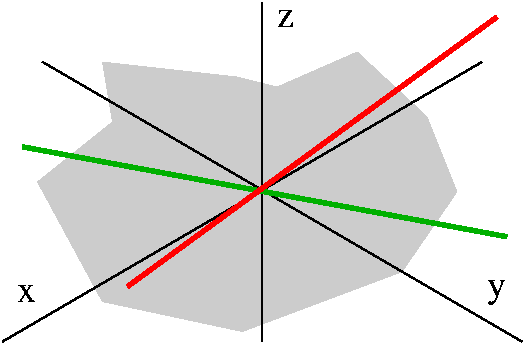 A really silly (?) two-variable example
A really silly (?) two-variable example
I gave a very artificial example to show that things can be quite
strange in more than 1 variable. I defined a function, f(x,y) to be 2x
if y=0, 3y if x=0, and 0 otherwise. To the right is an effort to show
the graph, z=f(x,y), of this strange function. The green line is
supposed to be tilted above the x-axis (the tilt or slope is 2), the
red line is tilted 3 over the y-axis, and the remainder of the graph
is flat at z=0, the xy-plane.
Certainly if you slice the graph by y=0 (this is called a vertical
trace in the textbook) then you get z=2x, and the partial derivative
of f with respect to x exists and is 2. That is,
∂f/∂x(0,0)=2. Similarly, if you slice the graph by x=0 then
you get z=3y, and the partial derivative of f with respect to y exists
and is 3. That is, ∂f/∂y(0,0)=3.
This is a seriously silly function, but let me analyze it from the
point of view of differentiability at the point (0,0). Suppose that h
is a small perturbation in the first coordinate and k is a small
perturbation in the second coordinate. I would like to understand
f(0+h,0+y) in terms of the unperturbed value of f (that is, f(0,0)=0)
and also the first-order part (this should be ∂f/∂x(0,0)h=2h
and also ∂f/∂y(0,0)k=3k). So I ideally would like
f(0+h,0+y)=f(0,0)+2h+3k+H.O.T.
But look: what if both h and k are not both 0? Then we are on
the grey part of the graph, and the equation above becomes
0=0+2h+3k+H.O.T. whenever h and k are not both 0. We also want
H.O.T. to be truly "higher order" so it might have stuff like
h3/2 or k2 or even a combined higher order term
like hk. None of these will cancel out the 2h+3k. This extremely silly
(but rather simple) function does not have the approximation property
which we would like in differentiable functions. And it is this
approximation property which is needed in many applications -- this is
not "theory".
Repeating, looking at slices is not good enough to consider
limits and continuity. Slices, even collections of slices in two
perpendicular directions, just do not contain enough
information about the function. In the case of f(x,y) and its partial
derivatives, the key idea, both abstractly and computationally, turns
out to be the two dimensional analog of (approximate) local
linearity. If we "kick" the input to f in both x and y, we need to
understand how the function "responds". The nicest response, similar
to one dimension, would be the unperturbed response, f(x,y), then
something proportional to h plus something proportional to k, and,
finally, a higher-order error term.
By the way, if you don't like piecewise defined functions, you could
consider the function defined by this formula:
f(x,y)=xy/sqrt(x2+y2). It has properties which
are similar to the piecewise function, but it is a bit harder to
analyze. You could look at it using Maple, and then you might get some insight.
Differentiable in two variables
In mathematics, when something is wrong, one way to help is by making
a definition. The functions we want to consider are called
differentiable and have exactly the property that they can be
approximated nicely.
f(x,y) is differentiable at (x,y) if there are numbers
Constant1 and Constant2 so that for h and k
small,
f(x+h,y+k)=f(x,y)+Constant1h+Constant2+Error,
where the Error term→0 faster than |h|+|k| (so, faster than first
order).
Important results
Before hysteria strikes, here are two results which are verified in
the text. They are not difficult to check (again, the essential key is
the 1-variable Mean Value Theorem), but we just don't have time in
class.
Theorem If f(x,y) is differentiable, then the partial
derivatives of f(x,y) exist, and
Constant1=∂f/∂x(x,y) and
Constant2=∂f/∂y(x,y).
Theorem If ∂f/∂x and ∂f/∂y are both
continuous then f(x,y) is differentiable (in the approximation
sense defined above).
Please realize that essentially all functions we will meet in Math 251
will satisfy the hypotheses of the preceding theorem, so these
functions will be differentiable and will have suitable
approximation properties. In fact, here is a sort of easy example,
although there is some computation involved.
Linear approximation: an example
Here we looked at something like
f(x,y)=sqrt(x4-y2+2xy-3). Notice that
f(2,3)=sqrt(24-32+2·2·3-3)=
sqrt(16-9+12-3)=4. This is an example in a calculus class, and it was
chosen so that f(2,3) was nice.
Then
∂f/∂x=(1/2)sqrt(x4-y2+2xy-2)-1(4x3+2y)
and
∂f/∂y=(1/2)sqrt(x4-y2+2xy-2)-1(-2y+2x).
We can evaluate these derivatives at (2,3):
∂f/∂x(2,3)=(1/2)(1/4)(4·23+2·3)=(38)/8
and ∂f/∂y(2,3)=(1/2)(1/4)(-2·3+2·2)=-2/8.
If we want a linear approximation to f(2.03,2.98), then we may
use the following formula:
f(2.03,2.98) is approximately f(2,3)+∂f/∂x(2,3)(.03)+∂f/∂y(2,3)(-.02).
Here the change in x from 2 to 2.03 means that h is .03 and the change
in y from 3 to 2.98 means that k is -.02. The linearized approximation
gives us 4+(38/8)(.03)+(-2/8)(-.02) which is 4.1475. The "true value"
(well, up to 10 decimal places) of f(2,3) is 4.147314409.
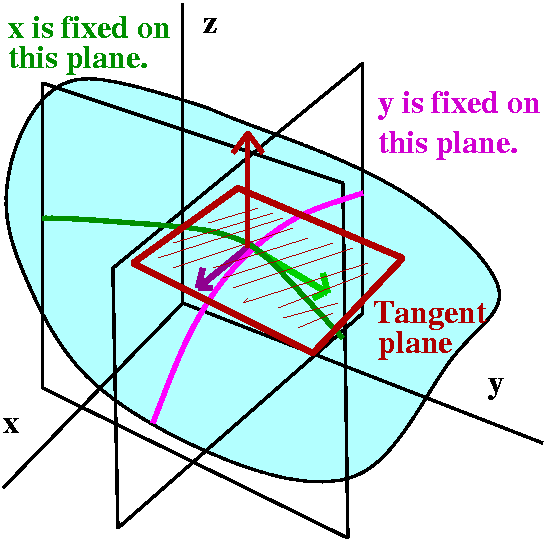 Tangent planes
Tangent planes
We can get a bit more out of the slicing picture. The vector i+∂f/∂xk is tangent to the curve in
R3 gotten by fixing y on the surface z=f(x,y), and the
vector j+∂f/∂xk is tangent to the curve in
R3 gotten by fixing x on the surface z=f(x,y). If the
surface is nice and smooth (that is, if the function f(x,y) is
differentiable) people agree that the two vectors determine a plane
which is tangent to
y=f(x,y). To write the equation of a plane, we need a point and a
normal vector.
Suppose we're at the point
(x0,y0,f(x0,y0)). The
normal vector will be perpendicular
to both i+∂f/∂x(x0,y0)k and j+∂f/∂x(x0,y0)k. So we need
to compute the cross product:
[i+∂f/∂xk]x[j+∂f/∂xk]. So:
( i j k )
det( 1 0 ∂f/∂x)=-[∂f/∂x]i -[∂f/∂y]j +k=a normal vector
( 0 1 ∂f/∂y)
Then if you remember the data needed to write a plane (a point and a
normal vector) we can write the equation of a tangent plane.
If f(x,y) is differentiable, then the equation of a plane tangent to
z=f(x,y) when x=x0 and y=y0 is
(z-z0)=∂f/∂f(x0,y0)(x-x0)+∂f/∂y(x0,y0)(y-y0).
I did an example, but as you will soon see, there's a better way of
thinking about this stuff and maybe even computing the things we need.
I did begin the nebula discussion in this class, but I decided
to put it all in "one place" so what I did on this day is glued
together with the stuff for Wednesday's class (October 1).
Wednesday, September 24
Nuclear magnetic resonance (NMR)
NMR
is a way of investigating the structure of molecules, relying on the
spin of protons and how this spin changes in high magnetic and
electric fields. Several "antiques" (objects more than 10 years old!)
were exhibited in class. These were contour plots, outputs of NMR
experiments. The lecturer believes students should be aware that real
data can be much more complicated than the examples likely to be seen
in this course! We (the instructors) are trying to prepare you to
understand and work with much more complicated real-life
situations.
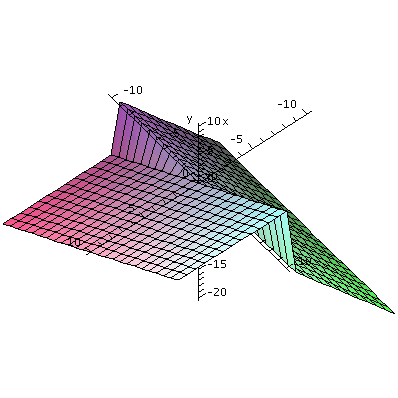 Two half planes
Two half planes
I defined a piecewise function to exercise "our" intuition.
( y if x>0
f(x,y)= (
(2x if x<=0
First, this function does depend on y. So we computed:
f(3,4)=4, f(-3,4)=-6, f(3,-4)=-4, f(-3,-4)=-6.
We discussed the graph of z=f(x,y). I made a bunch of mistakes -- I am
sorry. Really, my brain hardly works after 4 PM, and now you should
believe me.
The behavior on the two sides of the yz-plane (where x=0) is
different. More globally, the "rear" halfplane (where x<0) is a
half of a plane whose equation is z=y. This equation gives a plane
tilted at 45o to the y-axis. The front half, where x>0,
was a plane which was tilted up as y increased. The graph that is
shown is Maple's version. There are some real problems with
how the program shows this graph. The jumps, which we investigated
carefully, are connected because what Maple does is just connect
dots. So it connects the jumps even when these are not part of
the graph of the function (in 1 variable graphs, this "connecting"
idea can be turned off, but I don't know how to turn it off in several
variables). There are no vertical line segments in this graph!
I strongly recommend that you try to graph this function yourself, and
rotate the Maple plot systematically to understand what's going on.
How to define this function
Use the following, please:
>f:=(x,y)->piecewise(x>y,y,2*x);
This command tells Maple that if x>0, then the value of f(x,y) is
y. If the statement is false, the value is 2x. Then I loaded the
package plots and just used the commands
plot3d and contourplot.
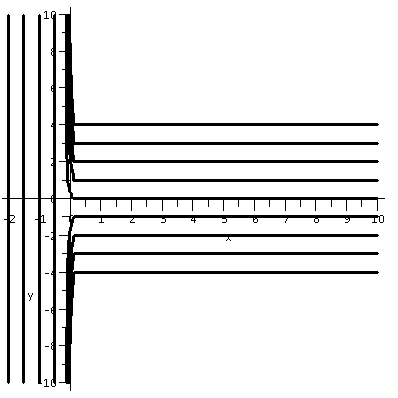
The contour "lines"
The contour lines are also not sketched too well. Most particularly,
the contour "line" f(x,y)=0 is very peculiar. It actually consists of
the y-axis together with the positive x-axis. Maple doesn't
want to draw anything like that, so it actually omits a line segment
in this T-shaped contour line. I tried various options with
contourplot but I could not get the T contour (C=0) drawn
correctly. The other contours are again for integer level sets. The
level sets for C>0 are horizontal half lines in the first
quadrant. The level sets fo C<0 have two pieces. One part is a
horizontal half line in the fourth quadrant, and one part is a whole
vertical line in the left halfplane. This may be hard to visualize. I
urged people to try to educate their intuition. The left lines are
closer together than the horizontal halflines. This is all very very
peculiar, but the worst is to come.
The suicidal bug
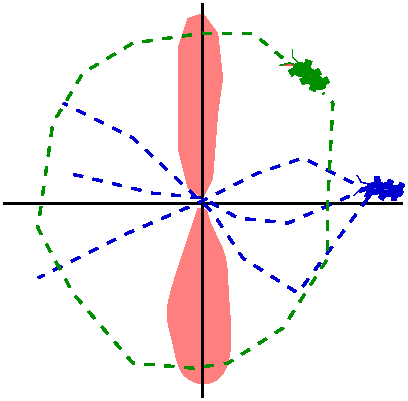 Now comes some of the harder stuff. I asked people to imagine that
some bugs were "walking" on the graph of z=f(x,y). The green bug, whose path is shown to the
right, strolls along in a path which is roughly circular around the
origin. This bug runs into trouble at any point on the positive
y-axis, where there's a drop. It also has problems along the negative
y-axis, where again there is a big difference in heights. This is a
very small bug. I have tried to indicate this by a sort of light
reddish color surrounding these half-lines. The
blue bug walks from the right halfplane to the left
halfplane. It is careful to cross only at the origin. The blue
bug is totally safe, and never comes across any severe height
differences. So I would like to discuss (and name [define], since it
is a math course!) the differences the bugs encounter more precisely.
Now comes some of the harder stuff. I asked people to imagine that
some bugs were "walking" on the graph of z=f(x,y). The green bug, whose path is shown to the
right, strolls along in a path which is roughly circular around the
origin. This bug runs into trouble at any point on the positive
y-axis, where there's a drop. It also has problems along the negative
y-axis, where again there is a big difference in heights. This is a
very small bug. I have tried to indicate this by a sort of light
reddish color surrounding these half-lines. The
blue bug walks from the right halfplane to the left
halfplane. It is careful to cross only at the origin. The blue
bug is totally safe, and never comes across any severe height
differences. So I would like to discuss (and name [define], since it
is a math course!) the differences the bugs encounter more precisely.
Limits in one dimension
In one variable, limits are relatively simple. To define
limx→af(x) we look at how x gets close to a from both
sides. There are some standard pictures and standard examples of
bad situations. Below are a few, to remind you.
| Bad limiting behavior in dimension
1 |
|---|
| A jump
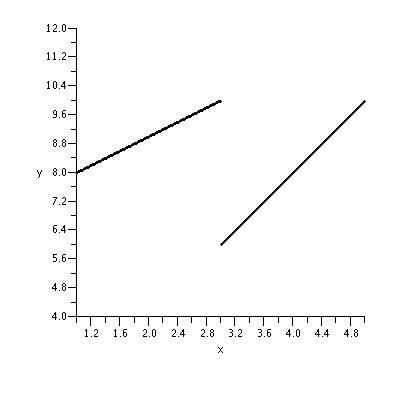
(y=x+7 for x<3, and 2x otherwise.)
|
Many wiggles
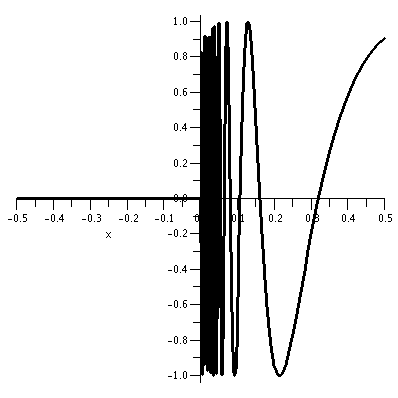
(y=sin(1/x) for x positive, y=0 otherwise.) |
Several variables
In several variables limiting behavior can be quite complex, much more
than with one variable. I tried to give a few examples.
Many straight line limits exist
I asked students to consider the function
f(x,y)=xy/(x2+y2)
This is an algebraic
formula which behaves is a strange fashion for (x,y) near (0,0). We
could try some values, but we can also take advantage of the
appearance of x2+y2. Almost always that's a
signal to at least attempt to understand things in polar coordinates
-- that is, to take advantage of circular symmetry.
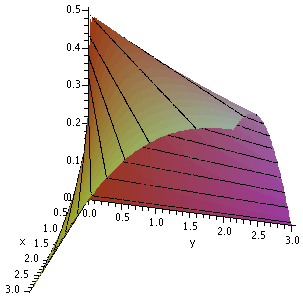
Since x=r cos(θ) and y=r sin(θ), we know that
x2+y2=r2 and
xy=r2cos(θ)sin(θ). Therefore
f(x,y)=xy/(x2+y2)=cos(θ)sin(θ)
The
value of f(x,y) only depends on the angular part of the polar
coordinate representation of (x,y) and not at all on the radial
component. The graph is made up of a bunch of half lines all parallel
to the xy-plane, radiating out from the z-axis. These halflines, since
cos(θ)sin(θ)=(1/2)sin(2θ), all have height between -1/2
and +1/2.
A Maple graph of the surface over the first quadrant (x>0
and y>0) is shown to the right. I also attempted, with the help of
a stalwart student accomplice, to "draw" the surface kinetically. The
student "volunteer" held one end of a bungee cord under some tension
(both in the student and the cord!) while the calculus instructor held
the other end and walked around the student. The calculus instructor
raised and lowered the cord twice and the student was asked to keep
the end of the cord at the same level as the instructor's
end. Therefore along every angle a limit existed, but as the angle
changed, the limits changed. There were infinitely many
different limits possible along straight line approaches to
(0,0).
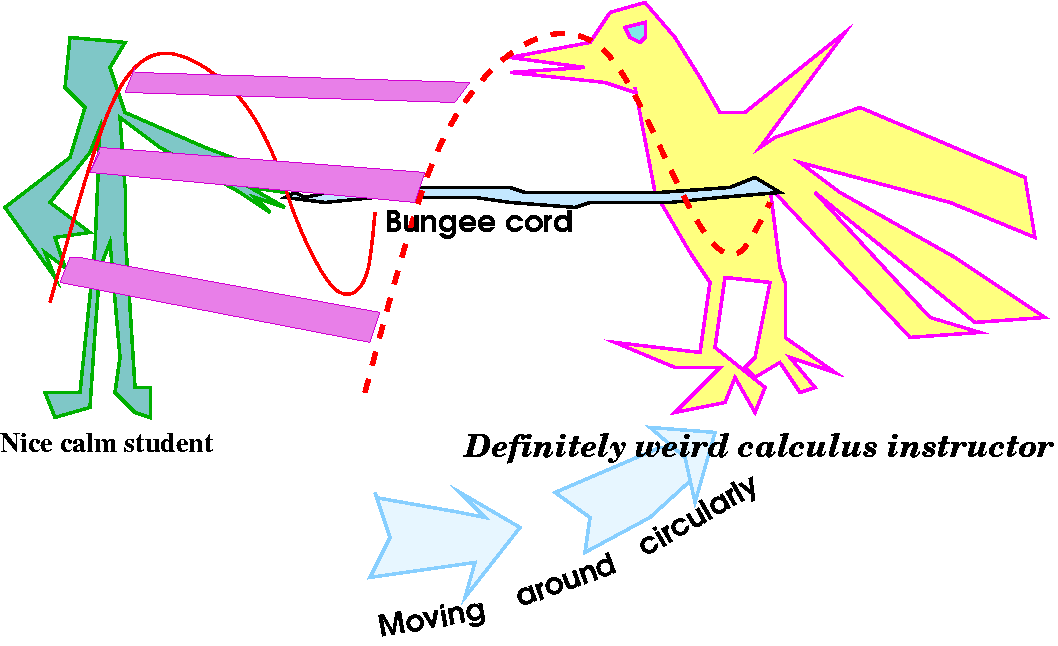
Always 0 on a straight line approach
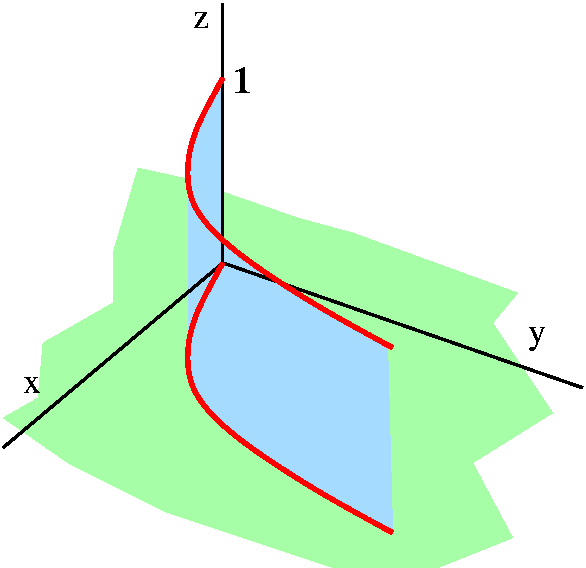 The final example of misbehavior was the following function:
The final example of misbehavior was the following function: ( 1 if y=x2 and x>0
f(x,y)= (
( 0 otherwise
This function has only two values, 0 and 1. Certainly if you "walk"
towards 0 on a straight line approach in the second, third, and fourth
quadrants, the function values are all 0 and therefore the limit is
0. What's not so obvious perhaps is the behavior of the function on
straight line approaches in the first quadrant.
Look at y=x. This line intersections y=x2 only at x=0 and
x=1. So if we "walk" towards the origin on this line from some large
x>0 considering the values of the function f(x,y), the function
will be 0 at every point except x=1 where it will be 1. Certainly the
limit as x→0 will exist, and it will be 0.
In fact, the limit exists on every straight line approach to (0,0),
and the value of the limit is 0. But the real, two-variable limit
should not exist, because the values of f(x,y) do not get close to 0
as (x,y)→(0,0).
QotD
I introduced ∂ by just using
it.
Example 1 If F(a,b,c)=a2b-3bc3 then
∂F/∂a=2ab and ∂F/∂b=a2-3c3 and
∂F/∂c=-9bc2.
Example 2 If F(a,b,c)=a3sin(7b-5c2) then
∂F/∂a=3a2sin(7b-5c2) and
∂F/∂b=a3cos(7b-5c2) and
∂F/∂c=a3cos(7b-5c2)(-10c).
Limits, 1 dimension
Here we've got a function of one variable, and we want to define and
understand limx→af(x)=L. The actual definition,
frequently stated but rarely stressed in calc 1 classes, is the
following: (and, yes, the Greek letters ε and δ
are almost
always used)
|
Given any ε>0, there is some δ>0 so that if
0<|x-a|<δ, then |f(x)-L|<ε.
|
One way to possibly understand this is uses the model of a "function
box" as I did in class: a box labeled "f" which has input and
output. In this model, the ε is an output tolerance. We'd like
our outputs to be within ε of the ideal output (for this
problem) L. Then the limit definition states that there is some input
tolerance, δ, which when applied to stuff going into the machine
(only allowing inputs within δ of the initial input) then the
output tolerance will be satisfied. The definition itself may be
difficult to understand for several reasons. First, it is a
complicated logical statement, Second, it provides no structure for
computing or even estimating δwhen actually given an
ε. To me, this is a bit distressing. But some understanding of
the input/output model and its approximation properties is fine right
now.
Limits, 2 dimensions
We looked at several examples which were not continuous and
did not have limits at (0,0). Let me show you the actual mathematical
definition of lim<x,y>→<a,b>f(x,y)=L. It is
very analogous to the 1 dimensional definition quoted above:
|
Given any ε>0, there is some δ>0 so that if
0<|<x,y>→<a,b>|<δ, then |f(x,y)-L|<ε.
|
Again the εand δare output and input tolerances,
respectively. The interesting feature to me is
|<x,y>-<a,b>|. This means the distance from <x,y>
to the point <a,b>. This is distance in any direction, along any
path. The examples we saw last time only considered approaches to
<a,b> along straight line segments. This turns out not to be
enough. You've got to allow any paths, and, in fact, allow
consideration of all points close to <a,b> (a sort of blob
completely surrounding <a,b>). I think this makes limits much
more "strict" in several dimensions.
Derivative, 1 dimension
What does f´(x)=Q mean? The definition we all tried to memorize
(for a while, anyway) went something like this:
This definition is difficult to compute with because it has division
and subtraction. People frequently "unroll" it to the following:
Here f(x) is the old, unperturbed output or response of f to the input
of x. We perturb (kick?) the function box with a small w. The response
of f to x+w can be decomposed (if f is
differentiable!) into f(x), the old response, a linear or first-order
disturbance, Qw, and "Error". The Error term is very complicated. Of
course it will depend on f and x and w (and maybe the phase of the
moon). But what is most important about the error term
computationally is that it approaches 0 faster than first
order. Frequently in applications the Error term is thought of or
labeled, H.O.T. for "higher order terms". A function is differentiable
in one variable exactly when its response to a small kick can be
described as above. This corresponds geometrically to a well-known
phenomenon that can be demonstrated nicely using graphing
calculators. If you take a point on the graph of a
differentiable function and zoom in repeatedly on the graph
(centered at the point) within usually a few "zooms" the graph begins
to look like a straight line (this is certainly not true of
f(x)=|x| at x=0!). Therefore the graph of y=f(x) is (approximately)
locally linear exactly when the function is differentiable. It is the
property of being approximately locally linear which turns out to be
important in higher dimensions.
|
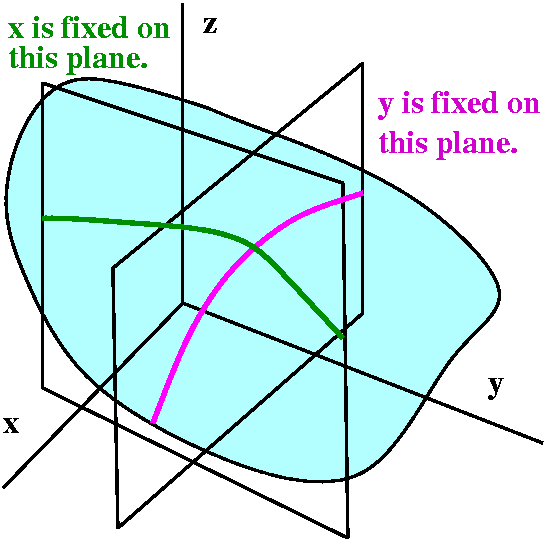 Slicing and partial derivatives
Slicing and partial derivatives
Now we can define partial derivatives. Please realize that everything
we are doing can be done in any number of variables (want a
picture of 703 dimensions?) but I'll stick with 2 dimensions here
because I can draw pictures and I like pictures.
So look at a graph of z=f(x,y). We can slice this in various ways. For
example, we could slice this by a plane
perpendicular to the y axis with y fixed. This will give sort
of an z-x curve. We could "lift" that curve up and just consider it as
a function of one variable, x, and then look at the derivative. That's
∂f/∂x. This notation, with a sort of curly d, is not
terrific, and it can be (as we will see) quite confusing. But it is
what almost everyone uses. Similarly, we could slice by a plane perpendicular to the x axis with x fixed
and consider the derivative of the resulting curve or function. That
will be ∂f/∂y. Here are the formal definitions if you would
like them:
limh→0(f(x+h,y)-f(x,y))/h=∂f/∂x
limk→0(f(x,y+k)-f(x,y))/k=∂f/∂y
|
I'll use h for little changes in the first variable and k for little
changes in the second variable.
I did some silly examples and then actually computed some partial
derivatives of 1/sqrt(2πt)e-x2/t. This
function occurs in many applications analyzing diffusion, including
heat and fluid mixing.
This is lecture #7, and I've "covered" up to section 14.3, so I am
already (!) a section behind the syllabus.
Monday, September 22
Please remember this basic information about a
right circular helix. Click on the link and reread what we did if you
need to.
Here r(t)=a*cos(t)i+a*cos(t)j+btk, the position vector. The velocity
vector is r´(t)=-a*sin(t)i+a*sin(t)j+bk. The length of this
velocity vector is
sqrt([-a*sin(t)]2+[a*sin(t)]2+b2). This
simplifies because we know that
sin2+cos2=1. There are very few other
curvature computations which are so simple.
So ds/dt=(sqrt(a2+b2)) (the length of the
velocity vector, which is the speed) and we get the unit tangent
vector by dividing the components of r´(t) by ds/dt. SO
T(t)=(1/sqrt(a2+b2))(-a sin(t)i+a cos(t)j
+bk). According to what we did last time, if we differentiate this we
should get a vector perpendicular to T(t). So d/dt(T(t))=
=(1/sqrt(a2+b2))(-a cos(t)i-a sin(t)j+0k). If
you take the dot product of this with T(t) you will get 0 (the
strange-looking signs make that true). But this is d/dt(T(t)) and I
want for curvature d/ds(T(t)). The Chain Rule suggests that I divide
d/dt(T(t)) by ds/dt to get d/ds(T(t)). If I do this, the result is
(1/(a2+b2)(-a cos(t)i-a sin(t)j+0k). Wow. We
are not done yet. This should be κN: that is, it should be the
curvature, a positive number, multiplying a unit vector, and this is
the unit normal vector. If you stare at what we have you should
eventually see the following:
dT/ds=(1/(a2+b2)(-a cos(t)i-a sin(t)j+0k)=[a/(a2+b2)](-cos(t)i-sin(t)j)
Here what is in blue is a scalar, multiplying
what is in green which is a unit
vector. Therefore what is in blue is κ,
the curvature, and what is in green is the
unit normal vector. By the way, this is why everyone (and me too, darn
it, me too!) uses formulas such as those in the book to compute these
things, because going directly from the definition is too darn
complicated.
If κ=[a/(a2+b2)] for the
helix, how does this match up with our forecasts? Here is the scorecard.
- If a→∞, then κ→0+. The curve gets
flatter.
Well, when a gets large, basically we have a1 on top and
essentially a3 on the bottom. The result certainly does
→0.
- If b→∞, then κ→0+. The slinky (?)
gets stretched out more.
Here if a is fixed, and b gets really large, again the result ;→0
because b only appears on the bottom.
- If a=0, then κ=0. The curve is a straight line.
True -- set a=0 in the formula.
- If b=0, then κ=1/a. The curve is a circle.
Again, if b=0 in the formula, then the result is a/a2
and this is 1/a.
Very few other computations of curvature are this simple.
Here are some pictures of various helices produced by Maple (the plural of "helix" is
"helices").
The pictures below were produced using the command
spacecurve([a*cos(t),a*sin(t),b*t],t=0..6*Pi,
axes=normal,color=black,thickness=2,scaling=constrained,numpoints=180);
The procedure spacecurve is loaded as
part of plots using the command with(plots);. I used the option scaling=constrained in order to "force" Maple to display the three curves with similar
spacing on the axes. Otherwise the x and y variables would be much
altered in each image. I hope that these pictures give some idea of
what the curvature and torsion represent.
| Some helices: x=a cos(t) &
y=a sin(t) & z=bt
|
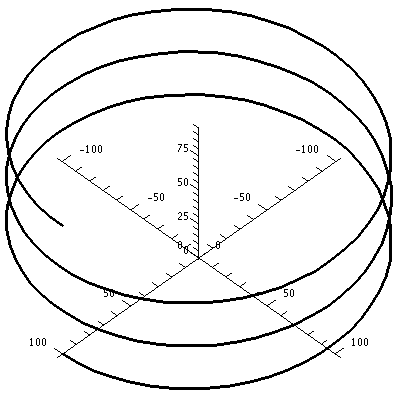 | 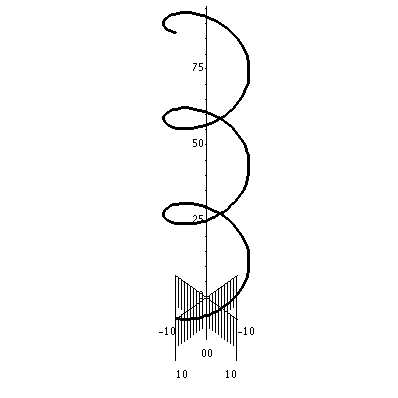 | 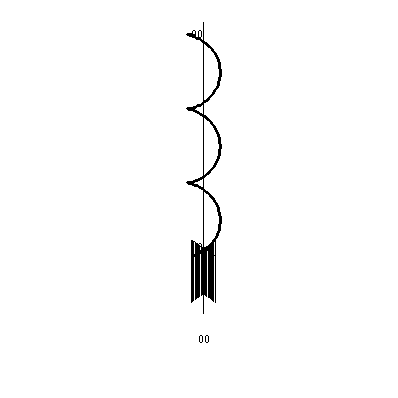 |
a=100 & b=5
κ=.01 |
a=10 & b=10
κ=.05 |
a=5 & b=100
κ=.0005 |
|
The curvature of the twisted cubic
O.k., I tried to compute the curvature of
r(t)=ti+t2j+t3k. I used a formula from section 13.4:
κ=||r´xr´´(t)||/(||r´(t)||)3.
Even though this formula looks weird, it is much better to use than
trying the definitions (I have tried using the definitions with this
example, and the computations are terrible).
So r´(t)=1i+2tj+3t2k and
r´´(t)=0i+2j+6tk. Now for the cross product computation:
| i j k |
det| 1 2t 3t2| = det|2t 3t2| i– det|1 3t2| j + det|1 2t|k
| 0 2 6t | | 2 6t | |0 6t | |0 2|
And then I evaluated the 2-by-2 determinants, so we saw that the
vector on the top of the formula for κ is
(12t2-6t2)i-6tj+2k=(6t2)i-6tj+2k. But
we need the magnitude or length of this for the top, and this is
sqrt(36t4+36t2+4). Wow. The bottom is "just" the
three-halves (!) power of the length of the velocity vector, and this
is (1+3t2+9t4)3/2.
Therefore (as they write in textbooks) the curvature of the twisted
cubic is
sqrt(36t4+36t2+4)
---------------------
(1+3t2+9t4)3/2
Now, having done this ludicrous computation, I will admit that I get
almost nothing out of it. Here is this ridiculous formula, and what
does it tell me? Well, maybe a little bit. If t is very large positive
or very large negative, it seems to say that the curvature gets small
(look at the "net" power of t on top, maybe a t2, and on
the bottom "net" a sort of t6). I guess this means that the
curve gets flatter as |t|→∞. Maybe this is interesting. (It sort of resembles y=x2 that way.)
How to think of all this?
What would I like "you" (especially the engineer and physics "yous")
to take away? Another formula from the textbook (section 13.5) resembles exactly what we already saw in two dimensions:
r´´(t)= (d2s/dt2)T +
κ(ds/dt)2N
This is a decomposition of the acceleration vector into
tangential and normal components, and actually has some interesting
information about physical quantities. Remember that F=ma, and mass is
a scalar, so that the Force an object "feels" is exactly a scalar
multiple of its acceleration. So let me look at two special cases.
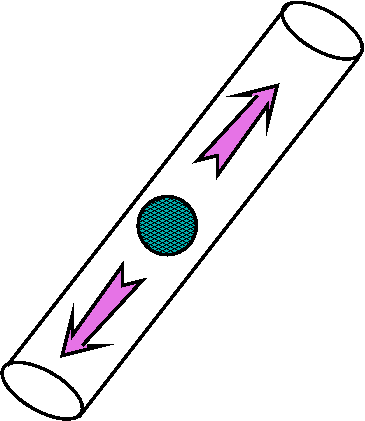
Motion in a straight line
Imagine a ball bearing (?) moving in a straight tube. I claim that the
tube never "feels" any force from the walls of the tube. Why? Well,
since for a straight line κ=0, the coefficient of the normal
component of the acceleration, κ(ds/dt)2, is always
0, for any motion, and therefore, since force is a scalar
multiple of acceleration, the force also must have zero normal
component. So the ball bearing can be pushed along or back in the
tube, but it is never pushed against the wall if you
insist that the ball bearing move in a straight path.
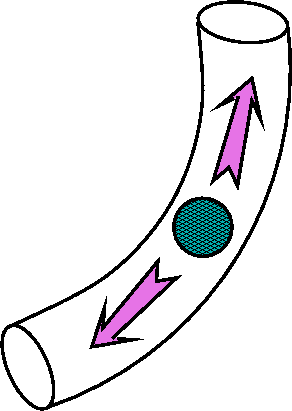 Motion in a circular arc
Motion in a circular arc
Now a more complicated thought experiment. Imagine the ball bearing
constrained to move in a piece of a circular tube. All we know is that
the object is moving, and its motion is part of a circular arc. I
claim that then/ no matter what, the ball bearing is "feeling"
a transversal (normal) force from the "walls" of the tube. Why? Well,
again the normal component of the acceleration (a scalar multiple of
the force acting on the object) is κ(ds/dt)2. Well,
κ is not 0 since it is 1/(radius of the circle). And, since the
object is moving, we also know that ds/dt is not 0. Therefore the
product isn't 0, and the normal component of the acceleration isn't 0.
This is, of course, related to the wonderful primitive experiment of
quickly spinning a bucket of water on a rope -- and the water is
"pushed" into the bucket by the "centrifugal force". Hey, that force
is a scalar multiple of the normal component of the acceleration of
the bucket's motion. It really works.
Just a little bit more ...
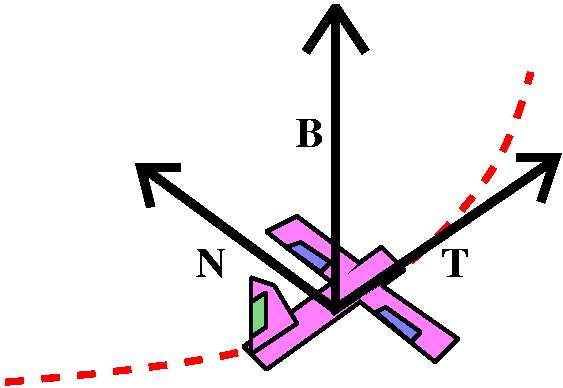 I hate to leave this subject since there is much more to be told, and
everything turns out to be amazingly useful in a wide variety of
applications. I hate to leave the subject, but the course is very
dense. So: just a little bit more. Think of an airplane flying along a
curve in the sky (the dashed red line). Then the unit tangent and
normal vectors are as shown. There's another vector, B, called the
binormal vector, which is TxN. Since T and N both have
length 1 and they are perpendicular, then B also has length 1 (sine of
a right angle is 1). And B is perpendicular to both T and N. The path
is determined by two functions. One of these functions is curvature
which says how much the plane is being pulled from a straight line. It
measures how much the T is changing in the N direction. Thegreen surface on the tail or the rudder of the
plane is the major object determining κ. But the motion is
three-dimensional. The way the binormal, B, changes, says how much the
plane is twisted out of the two dimensional plane determined by T and
B. The rate of change of B is called the torsion, and is
usually denoted by τ, the Greek letter tau. It is determined
mostly by the angles that the blue control
surfaces have with the wings. When a plane takes off or is landing,
these surfaces have relatively high angle to the wings.
I hate to leave this subject since there is much more to be told, and
everything turns out to be amazingly useful in a wide variety of
applications. I hate to leave the subject, but the course is very
dense. So: just a little bit more. Think of an airplane flying along a
curve in the sky (the dashed red line). Then the unit tangent and
normal vectors are as shown. There's another vector, B, called the
binormal vector, which is TxN. Since T and N both have
length 1 and they are perpendicular, then B also has length 1 (sine of
a right angle is 1). And B is perpendicular to both T and N. The path
is determined by two functions. One of these functions is curvature
which says how much the plane is being pulled from a straight line. It
measures how much the T is changing in the N direction. Thegreen surface on the tail or the rudder of the
plane is the major object determining κ. But the motion is
three-dimensional. The way the binormal, B, changes, says how much the
plane is twisted out of the two dimensional plane determined by T and
B. The rate of change of B is called the torsion, and is
usually denoted by τ, the Greek letter tau. It is determined
mostly by the angles that the blue control
surfaces have with the wings. When a plane takes off or is landing,
these surfaces have relatively high angle to the wings.
This is all a big simplification, but it is mostly
correct.
There is more about all this in the textbook if you are interested.
We move on to one of the major topics of the course. The word
"several" is almost technical in mathematics, and means "more than
1". We will start with an almost ludicrously simple function.
x2+y2
Here f(x,y)=x2+y2. This is a function defined by
a formula (essentially all of the functions we'll consider in this
course will be defined by formulas). The notation means that the input
to the function is an ordered pair of numbers, (x,y), and the output
is one number. Here the output for the ordered pair (-2,3) is 13.
Formalities: domain and range
The domain will be the collection (the "set") of all possible
inputs. Just as in calc 1, if the function is defined by a formula,
then the domain will be all inputs for which the function makes
sense. The usual restrictions that will concern us are:
- Don't divide by 0.
- Square roots of non-negative numbers only (same for other even
roots).
- Logarithms only for positive numbers.
These should all be familiar to you.
The range will be the collection of all possible outputs. You
may remember from calculus that while determining precise domains is
often possible but tedious, precise descriptions of ranges can be
quite difficult (this can involve exact determinations of max and min
values).
Here are some examples chosen to illustrate the likely possible restrictions. I certainly did not have time to discuss all
of these in class.
| f(x,y)=x2+y2 |
|---|
Domain
I think all pairs (x,y) of real numbers, all of R2.
|
Range
Since squares are non-negative, certainly the values of this function
are non-negative. And f(0,0)=0, and f(sqrt(A),0)=A for A positive. I
am just verifying precisely that the range is all non-negative real
numbers.
|
| f(x,y)=1/(y-x2) |
|---|
Domain
So this example is chosen to illustrate the restriction about not
dividing by 0. The domain is
all pairs (x,y) of real numbers for which y is not equal to
x2. Geometrically, this means all points of R2
which are not on the parabola y=x2.
|
Range
Well, 0 isn't in the range (it isn't the reciprocal of any
number). But everything else is: check this by just looking at what
happens to (0,A), which gives 1/A for all non-zero A's.
|
| f(x,y)=sqrt(y-x2) |
|---|
Domain
So this example is chosen to illustrate the restriction about square
roots. The parabola y=x2 divides R2 into two
pieces. One piece contains, say, the point (3,4) ("below" the
parabola). This point has y-x2=4-32=-5<0, so
(3,4) is not in the domain of this function. The domain is the
"other" piece of R2 and also those points which are on the
curve y=x2.
|
Range
The range is all non-negative numbers. Again, to check this you could
look at what happens to (0,A) for A>=0.
|
| f(x,y)=ln(y-x2) |
|---|
Domain
I still must "throw out" the part of R2 which is below the
parabola. But here inputs to ln must be positive, so the domain
does not include the curve y=x2. The domain is all of the
points in R2 which are above the parabola.
|
Range
The range is the range of ln, which is all real numbers.
|
Kinds of graphs
| Let me return to the
simplest of the functions I just considered:
f(x,y)=x2+y2. There are various graphs which are
commonly used. Maybe the simplest is to consider the points (x,y,z) in
R3 which satisfy the equation
z=x2+y2: this is usually called the graph of
the function. A Maple representation
of this graph is shown to the right, and the procedure which produced
it is plot3d, part of the plots package. This is rather a simple
function, and I hope you can see the shape of this surface. It is a
cup, axially symmetric around the z-axis. It is called a
paraboloid.
I looked at this graph and studied curves for fixed values of x and y
(called traces in the textbook. These are just (?) parabolas
opening up. Piecing them together to get this parabolic cup is not
totally obvious.
| 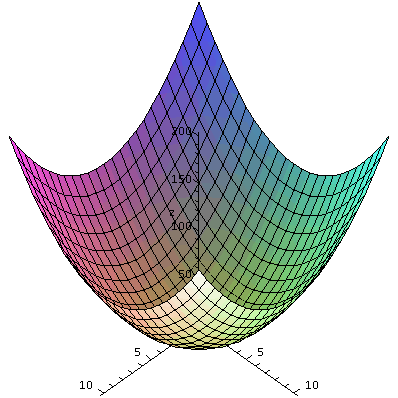 |
Another kind of plot, or, anyway, some geometric clue to the nature of
the function, can be gotten by looking the contours of f(x,y). There
are topographic maps (say, used by hikers) which give a
two-dimensional representation of the information in the surface
picture above. Pick a constant, C, and look at the (implicitly
defined) "curve" f(x,y)=C. I put quotes around the word "curve"
because maybe it doesn't have to be a neat nice curve. (An example was
discussed in class, and is below.) To the right is a collection of
contours for f(x,y)=x2+y2. These contours
correspond to the positive integers 1, 2, 3, 4, 5, and 6.
Please notice how these contours, which are at evenly spaced
"heights", get closer together as the three-dimensional graph gets
steeper. Of course, if the contours are not labeled with the values of
the constants, I can't tell if the function is increasing or
decreasing! This picture was made with contourplot, another part of the
Maple package, plots.
|
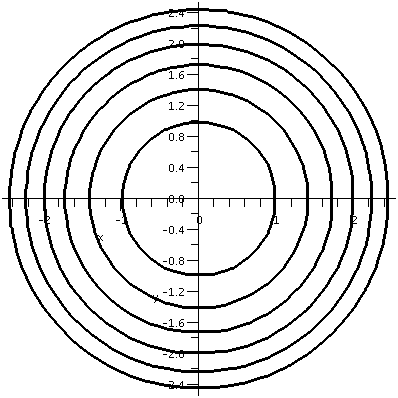
|
The origin in this paraboloid graph is a local and absolute minimum. I
briefly sketched a graph of f(x,y)=-x2-y2, which
is an upside-down version of what was just drawn. So it has a local
and absolute minimum. That's not too new. But let's consider something
weird and wonderful.
A saddle
Consider the function f(x,y)=x2–y2 (I'm
trying to exaggerate the minus sign typographically in this since
that's the most interesting part). The traces are again "just"
parabolas. But here, when, say, y=2 (a plane transversal or
perpendicular to the y-axis), we get f(x,2)=x2-4. So the
curve z=x2-4 is a parabola opening up. As we change the y's
in this sort of slice, the bottom of the parabola moves down for big
|y|.
What about the other traces, with x=a constant? Well, if x=3, then
f(3,y)=9-y2. In the plane perpendicular to the x-axis given
by the equaltion x=3, the curve is z=9-y2. a parabola
opening down. And by thinking we can see the top of these parabolas
moves up when |x| is large.
It is difficult for a novice to see how to put these curves
together. To the right is a Maple graph
of this function for -3≤x≤3 and -3≤y≤3. When you look at
this on the computer (please try!) you can rotate it and magnify it,
and things might become more clear.
|
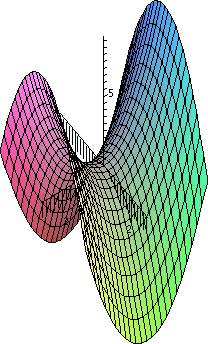
|
| The contour curves of this function are shown to the right.
Consider x2-y2=3, for example. One point on this
curve is x=2 and y=1, so look at the curve which goes through the
point (2,1). This curve is a hyperbola. The hyperbolas (each has two
pieces) corresponding to positive values of the function open left and
right. On the other hand, there is a family of hyperbolas opening up
and down. These correspond to negative values of the function.
And there's a special number. If x2-y2=0, then,
since x2-y2=(x+y)(x-y), the points on this
"curve" correspond to the two straight lines x=y and x=-y. (The
strange little box near (0,0) in the contour plot is because Maple thinks that very small +/- numbers which
it samples should also be 0. I am sorry about that. It may not be obvious looking at the curvy surface above that there are two straight lines on the surface. But there indeed are.
|

|
|
The point at the origin has a new kind of behavior, not found in one
variable calculus. In certain directions it is a maximum. In other
directions it is a minimum. This sort of point will be called a
saddle point (not too strange a name) or a minimax.
You could imagine that there will be a whole range of behaviors in
three hundred variables!
|
Actually there are a heck of a lot of straight lines on this surface,
many more than you might think. For example, if x=7t+4 and y=-7t+5 and
z=112t-16 (these are parametric equations for some sort of
straight line!) is actually on the saddle
z=x2-y2. This isn't obvious. I could insert the
formulas are check algebraically that
(7t+4)2-(-7t+5)2 is the same as 112t-16. Or I
could just show you a picture, to the right. After loading plots I typed >A:=plot3d(x^2-y^2,x=-10..20,
y=-10..20,axes=normal,color=green);
>B:=spacecurve(<7*t+3,-7*t+5,112*t-16>,
t=-2..2,color=red,thickness=3);
>display3d({A,B});
and I got a version of the picture displayed to the right. On the computer,
you can rotate it and play with it, and sort of convince yourself that the
straight line actually is on the graph. Sort of amazing.
Don't believe me! You try it.
|
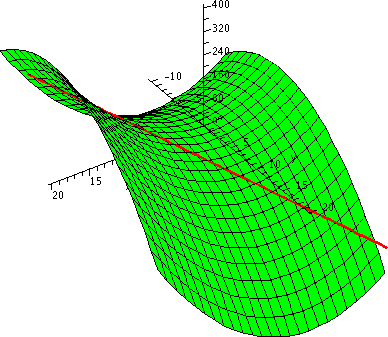
| |
Wednesday, September 17
... curving and twisting, forces and acceleration: a whole semester's
worth of ideas in one lecture!
Arc length
If speed is the magnitude of the velocity vector, then since
distance=rate·time, well, with variable speed, we need to chop
up the time interval and compute and add up pieces of distance. This
is the basic idea behind the definite integral, so it makes sense to
compute the distance along a curve from time t1 to time
t2 by this:
∫t1t2||v(t)|| dt.
O.k., this is good (all math is good!) but maybe some
examples ... will show how silly it is.
Textbook example
Here is an example taken from a textbook. Suppose
r(t)=<12t,8t3/2,3t2>. What is the length
of the curve from t=0 to t=1?
This is a typical artificial problem in a textbook. We know that
r´(t)=<12,8(3/2)t1/2,6t> so that the
speed is
||r´(t)||=sqrt{122+122t+36t2}. Now
we "remember" that distance=rate·time, and that the magnitude
of the velocity vector is ds/dt, the speed. So the total distance
traveled is
∫01sqrt{144+144t+36t2} dt.
Now look at the coincidences. We can pull out the 36 from under the
square root, and the result is
6∫01sqrt{4+4t+t2} dt, and,
what a coincidence, 4+4t+t2 is (2+t)2 and the
integral becomes 6∫01(2+t) dt=6(2t+(1/2)t2]01
and this is 6[2+(1/2)].
More realistically ...
Almost every combination of two or three functions, even rather
"simple" functions that you try to use as a position vector, will
yield something that can't be antidifferentiated in terms of familiar
functions. For example, look at the following mess:
> a:=t->t^3;
3
a := t -> t
> b:=t->cos(t);
b := t -> cos(t)
> c:=t->exp(t);
c := t -> exp(t)
> int(sqrt(a(t)^2+b(t)^2+c(t)^2),t=0..1);
bytes used=4000036, alloc=3407248, time=0.14
bytes used=8007244, alloc=5241920, time=0.30
1
/
| 6 2 2 1/2
| (t + cos(t) + exp(t) ) dt
|
/
0 And that means Maple tried but can't figure out
anything useful to reply except to echo the integral back to the
questioner. My next step is> evalf(%);
1.971185471
which asks for an approximate (numerical) evaluation of the
integral. That's almost always what's going to be necessary. Oh well:
the situation in textbook problems is much too nice.
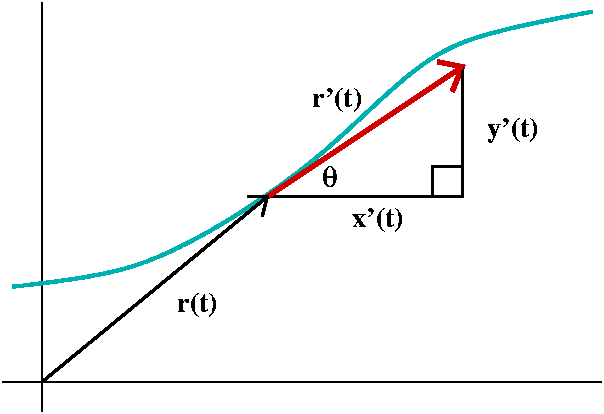 Curvature is a number which measures how a curve bends
Curvature is a number which measures how a curve bends
I tried to analyze the idea of how a curve bends. Curvature will be a
measure of this bending. I began an analysis that was apparently first
done by Euler in about 1750. I'll study plane (2-dimensional)
curves. A curve is a parametric curve, where a point's position at
"time" t is given by a pair of functions, (x(t),y(t)). Equivalently,
we study a position vector, r(t)=x(t)i+y(t)j. Here x(t) and y(t) will
be functions which I will feel free to differentiate as much as I
want.
There are some special test cases which I will want to keep in mind.
#1: a straight line
A straight line does NOT bend, so it should have curvature 0.
#2: a circle
A circle should have constant curvature, since
each little piece of a circle of radius R>0 is congruent to each
other little piece, and, in fact, the curvature should get large when
R gets small (R is positive), and should get small when R gets large
(and looks more like a line locally).
#3: "the" parabola
Even y=x2 might be a good test to keep in mind, since there
the curvature should be an even (symmetric with respect to the y-axis)
function of x, and should be bell-shaped, with max at 0 and limits 0
as x goes to +/-∞. The curve actually bends most near the
origin, and far away, when x is large positive or large negative, even
though the curve is very steep, it gets really flat.
The problem of understanding or defining curvature is to somehow
extract the geometric information from the parameterized curve. That
is, if a particle moves faster, say, along a curve, it might seem like
the same curve bends more. So what can we do? Somehow the
geometry of the curve should be separated from the dynamics
(kinetics?) of motion along the curve.
We looked at
θ, the angle that the velocity vector r´(t) makes with respect to
the x-axis. How does θ change? After some discussion it was
suggested that we look at the rate of change with respect to arclength
along the curve: that is the same as asking for the rate of change
with respect to travel along the curve at unit speed, and therefore
somehow the kinetic information will not intrude on the
geometry. This is the same as asking a bug to travel along the curve
at unit speed, and to describe the rate of change of θ (the
turning of r´(t), the velocity vector) as the bug strolls along
the curve.
The quantity s and the quantity t
Arc length, s, on a curve is computable with a definite integral:
sqrt(x´2+y´2) integrated from
t0 to t with dt is the arc length. As shown before, this is
rarely exactly computable with antidifferentiation using the usual
family of functions. But ds/dt is just
sqrt(x´2+y´2) by the Fundamental
Theorem of Calculus. And the Chain Rule suggests that d*/ds(ds/dt)=d*/dt if * is any quantity
of interest, such as θ. So to get d*/ds from d*/dt, multiply the
latter by 1/(ds/dt) which is
1/sqrt(x´2+y´2).
By drawing a triangle we see that θ is arctan of y´/x´:
θ=arctan(y´/x´). We can find dθ/dt: it is
(y´´x´-x´´y´)/(x´2+y2)2. This uses
the formula for the derivative of arctan, the Chain Rule, and the
quotient rule. Then the previous results say that
dθ/ds=(y´´x´-x´´y´)/(x´2+y´2)3/2,
a complicated formula. This is what's called curvature,
κ (the Greek letter kappa).
Back to the test cases
The straight line
We compute for some constants A and B and C and D:x(t)=At+B x´(t)=A x´´(t)=0
y(t)=Ct+D y´(t)=C y´´(t)=0
so that the top of the curvature formula is 0.
κ=0 for any straight line. |
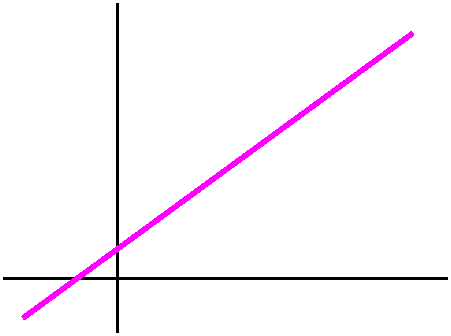
|
A circle
Suppose we have a circle of radius R centered at the origin.
Then parametric equations are not too difficult to get:x(t)=Rcos(t) x´(t)=-Rsin(t) x´´(t)=-Rcos(t)
y(t)=Rsin(t) y´(t)=Rcos(t) y´´(t)=-Rsin(t)
Let me look first at the bottom of the curvature formula. This is
(x´2+y´2)3/2. Notice that
x´2+y´2=R2([-sin(t)]2+[cos(t)]2)=R2,
so the 3/2´s power is R3. The top is
y´´x´-x´´y´ and this is
-Rcos(t)(-Rsin(t))--Rcos(t)Rcos(t)=R2·1. The whole
curvature formula is then R2/R3 which is 1/R.
When R is large, this is near 0. When R is close to 0 and positive,
this is large positive. And the curvature is constant which it should
be since the circle has the same local geometry at every point.
|

|
A parabola
Here I want to look at y=x2. A simple parameterization
is good. So let's try:x(t)=t x´(t)=1 x´´(t)=0
y(t)=t2 y´(t)=2t y´´(t)=2
Now the bottom of κ,
(x´2+y´2)3/2,
becomes (1+4t2)3/2, and the top,
y´´x´-x´´y´, is just 2. So
κ=2/(1+4t2)3/2.
Here the "local geometry" definitely changes from point-to-point. The
most curvy (?) part of the graph is at the origin. As x→+/-∞,
although the graph gets steeper and steeper, the curve locally
actually gets more and more flat: the curvature→0.
|
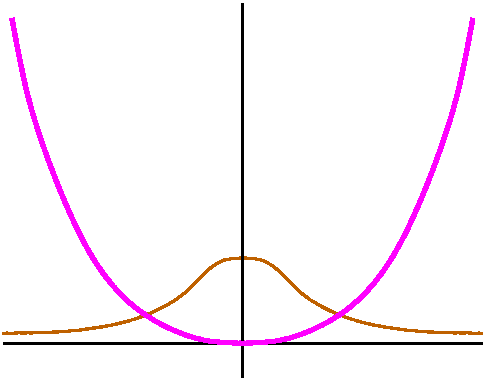
The smaller figure is supposed to be the curvature of the parabla.
|
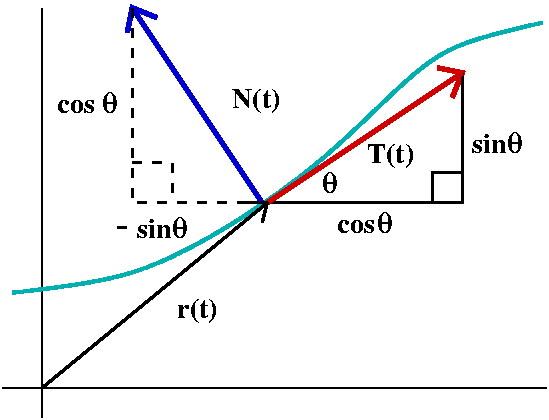 I defined the unit
tangent vector, T, to be a unit vector in the direction of
r´(t). If θ is the angle that r´(t) makes with the positive
x-axis, then T must be cos(θ)i+sin(θ)j.
Also r´(t)=(ds/dt)T, where ds/dt is the length of r´(t),
the speed. Now differentiate the formula for r´(t) using
one of the product rules we had stated earlier. The result is
r´´(t)=(d2s/dt2)T+ (ds/dt)d/dt(T). But T is
cos(θ)i+sin(θ)j, and differentiation with respect to t is the
same as differentiation with respect to s multiplied by ds/dt. But
differentiation with respect to s gives (-sin(θ)i+cos(θ)j)
multiplied by the derivative of θ with respect to s, and this is
κ. All this put together is:
r´´(t)= (d2s/dt2)T +
κ(ds/dt)2N
where N is (-sin(θ)i+cos(θ)j), a unit vector normal to T
(check this by dot product!), where N is called the unit normal.
I defined the unit
tangent vector, T, to be a unit vector in the direction of
r´(t). If θ is the angle that r´(t) makes with the positive
x-axis, then T must be cos(θ)i+sin(θ)j.
Also r´(t)=(ds/dt)T, where ds/dt is the length of r´(t),
the speed. Now differentiate the formula for r´(t) using
one of the product rules we had stated earlier. The result is
r´´(t)=(d2s/dt2)T+ (ds/dt)d/dt(T). But T is
cos(θ)i+sin(θ)j, and differentiation with respect to t is the
same as differentiation with respect to s multiplied by ds/dt. But
differentiation with respect to s gives (-sin(θ)i+cos(θ)j)
multiplied by the derivative of θ with respect to s, and this is
κ. All this put together is:
r´´(t)= (d2s/dt2)T +
κ(ds/dt)2N
where N is (-sin(θ)i+cos(θ)j), a unit vector normal to T
(check this by dot product!), where N is called the unit normal.
We have decomposed acceleration into the normal and tangential
directions. This can be significant physically and can help to
understand physical situations. Here are two "extreme" cases.
Straight line motion: no transverse forces
I used this to show that motion in a straight line (where
κ= 0) had no normal component, and therefore a particle
moving in a straight line had no force needed transverse to its motion
(remember force and acceleration are vectors related by the scalar m,
according to Newton's second law).
Moving in a circle: always normal force
On the other hand, in our circular
situation, the curvature was a positive number, and as long as the
particle was moving (ds/dt not equal to 0) a force was needed
to keep it on the circle. This is because the curvature
κ was non-zero, and so were the other terms. This is not
at all "intuitively clear" to me.
Silly example
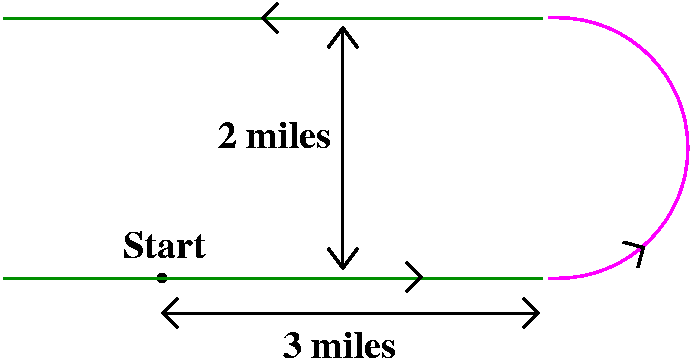 A racetrack: this racetrack consists, as nearly as possible, of two
straight line segments, each about 3 miles long, connected with a
semicircular track. Since the racetracks were specified to be 2 miles
apart, we "deduce" that the radius of the semicircle is 1 mile. The
racetracks certainly have curvature=0, and the semicircle, which is Pi
units long, has curvature 1. What would a graph of
the curvature of this racetrack look like?
A racetrack: this racetrack consists, as nearly as possible, of two
straight line segments, each about 3 miles long, connected with a
semicircular track. Since the racetracks were specified to be 2 miles
apart, we "deduce" that the radius of the semicircle is 1 mile. The
racetracks certainly have curvature=0, and the semicircle, which is Pi
units long, has curvature 1. What would a graph of
the curvature of this racetrack look like?
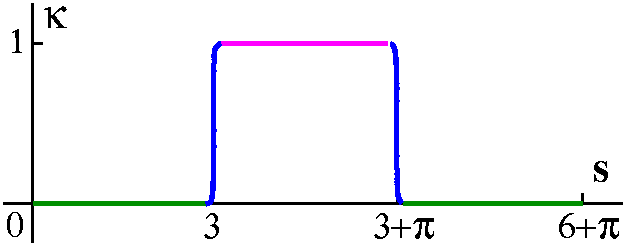 An answer
An answer
I attempted to be "correct" both qualitatively and quantitatively in
this graph. The blue curves are
my attempts to draw smooth transitions between the curvatures of the
circles.
|
Now let's look at space curves. The geometry of these curves,
as seen from the point of view of calculus (called "differential
geometry of space curves") is a subject which originated in the
1800's. The material presented here was stated in about
1850-1870. When I learned about this material in college, it mostly
seemed rather abstract and useless -- stuffy formulas no intelligent
person would care about. Like a number of other judgments about merit
that I've made in life, this is completely wrong. The geometry of
curves has within the last few decades become very useful in a number
of applications: robotics, material science (structure of fibers), and
biochemistry (the geometry involving the structure of big molecules
such as DNA): amazingly useful formulas and ideas!
The right circular helix
I'll carry along is a right circular helix as a basic example.
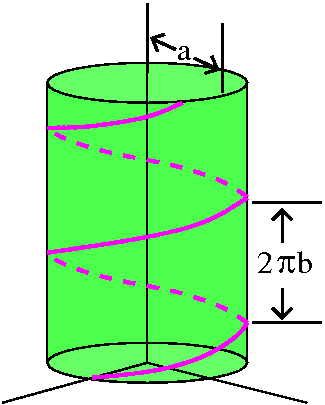
x(t)=a cos(t)
y(t)=a sin(t)
z(t)=b t
The quantities a and b are supposed to be positive real numbers.
This helix has the z-axis as axis of symmetry. It lies "above" the
circle with radius a and center (0,0) in the (x,y)-plane. The distance
between two loops of the helix is 2π b. The "b" changes the
pitch or angle of the screw threads modeled by the helix.
How should curvature behave for the helix? We discussed this and
decided κ should have these properties:
- If a→∞, then κ→0+. The curve gets
flatter.
- If b→∞, then κ→0+. The slinky (?)
gets stretched out more.
- If a=0, then κ=0. The curve is a straight line.
- If b=0, then κ=1/a. The curve is a circle.
Now let's analyze space curves
If r(t)=x(t)i+y(t)j+z(t)k (the position vector), then
r´(t)=x´(t)i+y´(t)j+z´(t)k=(ds/dt)T(t) is called the velocity vector.
Here T(t) is called the unit tangent vector and is a unit vector in
the direction of r´(t). ds/dt is the speed, and is
sqrt(x´(t)2+y´(t)2+z´(t)2), the
length of r´(t). We use ds/dt also to convert derivatives with respect
to t to derivatives with respect to s, as in two dimensions using the
Chain Rule.
Since T(t)·T(t)=1 differentiation
gives
T´(t)·T(t)+T(t)·T´(t)=0. But the dot product is
commutative, so this is 2T´(t)·T(t)=0 or just
T´(t)·T(t)=0.
This means that T´(t) and T(t) are always
perpendicular. In fact, we are interested in dT/ds, which is the same
as (1/(ds/dt))T´(t) (it is usually easier to compute T´(t) directly,
however, and "compensate" by multiplying by the factor
1/(ds/dt)).
Think about this sentence, which states a fact I'll use again and
again in this course:
Any
non-zero(!) vector is equal to the product of its magnitude times a
unit vector in its direction.
For dT/ds, the magnitude is
defined to be the curvature, κ, and the unit vector is
defined to be the unit normal N(t). This essentially coincides
with what's done for plane curves, when curvature was defined to be
d(θ)/ds.
I will continue with this material next time. I confess that I am
currently about 1/2 lecture behind the syllabus, but the formulas and
examples and concepts involving curvature are important and
complicated. Please read the textbook carefully and try the homework
problems in sections 13.3, 13.4, and 13.5. This is all work, but
please do this! I will compute the curvature for the helix next
time, and discuss some of the consequences of all of this stuff before
continuing with the syllabus.,
Monday, September 15
Vector functions of a real number
Now the course moves on: we will deal with functions whose domain is
all or part of R1 and whose range is R3. These
are vector-valued functions of a scalar variable. The motivation is
really the motion of points in space, and the analysis of the
resulting paths (curves). There will be interactions between motion
and geometry.
Parametric curves: a nuisance?
So I began with some irritating examples.
- The curve
r(t)=<t,t,t>. This curve is a straight line. It goes through the
origin, (0,0,0), and the path described is all of the line. The motion
described by this vector function (a triple of standard real-valued
functions) is uniform rectilinear (straight-line) motion.
- The curve r(t)=<t3,t3,t3>
is all of the straight line, but the kinetic aspect is very
different. Motion is not uniform, and gets faster as |t| gets larger
both positive and negative.
- Now the curve
r(t)=<t2,t2,t2> is not too
surprising. It is a half line or ray. Dynamically this represents the
motion of a point starting way out in the first octant where all of x
and y and z are positive, then coming in (slower and slower) to
(0,0,0). Then the point turns around (?) and starts out into the
octant again, retracing its path and going faster and faster.
- The curve r(t)=<sin(t),sin(t),sin(t)> is quite nasty
psychologically if discussed immediately after the line. All of the
coordinates are equal so every point on this curve is on the straight
line. Some thought is needed to force yourself to agree that the
"curve" is only a line segment from (-1,-1,-1) to (1,1,1) because
sine's range is [-1,1]. The motion described by this vector function
oscillates endlessly between the two points named.
Distinguishing between geometric aspects of the path of a particle and
the dynamic aspects of the particle will take up most of our next
class. This won't be obvious.
Two problems in the textbook
I tried to discuss two problems from the textbook. These pictures are
copied from page 743 of the text.
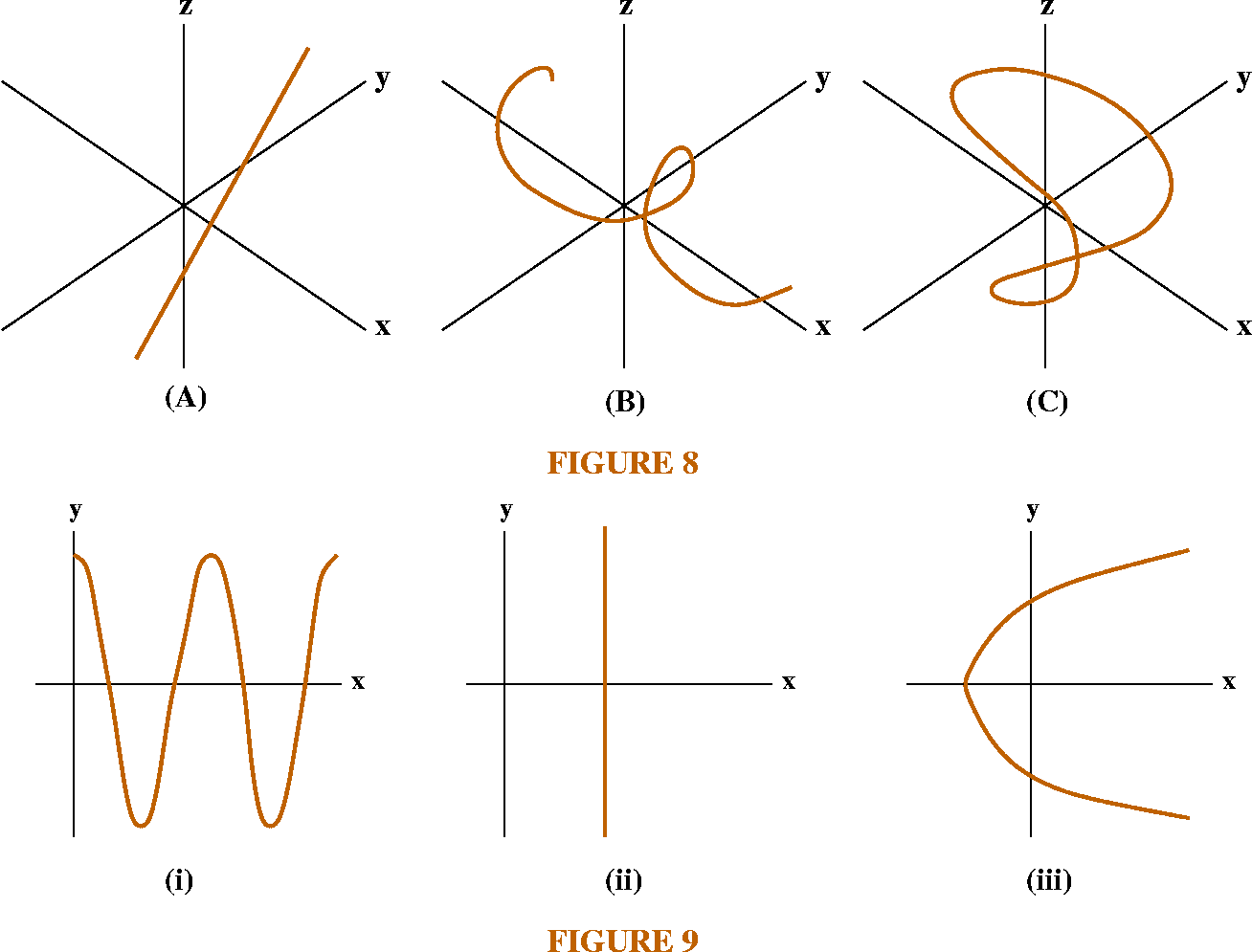
Problem 5 of section 13.1
Match the space curves in Figure 8 with
their projections onto the xy-plane in Figure 9.
Answer
How can we "solve" this problem? Well, I actually think most people
can solve the problem, but I think describing the process is somewhat
difficult. It is difficult because, for example, the pictures in
Figure 8 are two-dimensional. And they are images of some idea
three-dimensional situation. What can we see? Well, in Figure 8 (A) I
see a straight line. I believe that the straight line will not be made
"curvy" if we project into the xy-plane. Therefore the only candidate
which matches is the non-curvy (!) picture (ii) in Figure 9. What
else? Well, maybe the picture in (B) seems to be helical (more precise
information about a helix later). That's sort of a motion around a
cylinder whose axis of symmetry is, in this case, the x-axis. If we
push this down and neglect the z coordinate, I think what we get is
picture (i). This leaves (C) matching up with (iii). If you think
about a particle moving around the path indicated in (C), maybe
you see the xy-"squashing" of it moving back and forth along the
parabolic path in (iii). I was asked if there was somehow "proof" that
this was (iii), and, well, we're told that the triples of pictures
match up, and (C) and (iii) are what's left. It is certainly true that
something like (C) could have a more complicated squashing than what
is in (iii).
Problem 6 of section 13.1
Match the space curves in Figure 8 with the following vector-valued
functions:
(a) r1=<cos(2t),cos(t),sin(t)>
(b) r2=<t,cos(2t),sin(2t)>
(c) r3=<1,t,t>
Answer
Well, the linear formula is (c), and if we just
consider the first two coordinates, the 1 and the t, that would seem
to describe (ii), so I think that (c) is the algebraic version of
(A). As for (b), the first two coordinates are t and cos(2t) which
seem to describe (i). And if you consider the second and third
coordinates of (b), they are cos(2t) and sin(2t). The sum of the
squares of these is 1 (cos2+sin2=1) and the
first coordinate in (b) just moves the point along, so we get the
helix in (B). That leaves r1 in (a) to describe (C) and
(iii). Let's consider the first two coordinates of (a), which are
cos(2t) and cos(t). A trig identity you may/may not remember is
cos(2t)=2(cos(t))2-1. If we take x as cos(2t) and y as
cos(t), this becomes the equation x=2y2-1 which surely
looks like (iii). And the third coordinate, sin(t), of (a) makes the
image go up and down, up and down. So (a) is consistent with both (C)
and (iii). I think this third curve and formula are a bit interesting
and strange.
Pictures of a point in motion
Twisted cubic
The twisted cubic is the curve
r(t)=<t,t2,t3>. It is one of the beginning
curves shown to students in this subject, with the warning that here
is the pictures can be deceptive. A Maple command created a
3-dimensional viewing box of the curve. I rotated this box in various
ways and exported the images shown below.
spacecurve(<t,t^2,t^3>,t=-5..5,color=black,axes=normal,thickness=2);
| The view from the z-axis
Here we look down on the curve from high up on the z-axis. This has
the effect of suppressing (?) or deleting the z-coordinate from the
triple, and we just see the geometry of the first two coordinates:
(t,t2). Of course, this is the parabola y=x2.
|
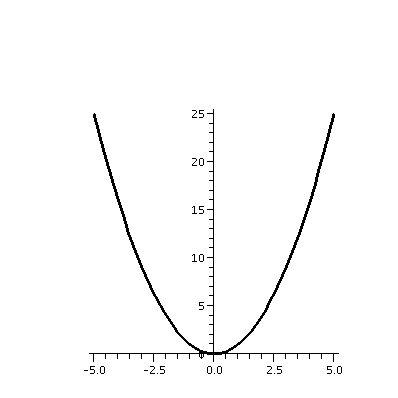
|
| The view from the y-axis
Now delete the central variable. In the xz-plane, the curve is the
collection of points (t,t3) and this is z=x3,
which is, I hope, a fairly familiar cubic. And, indeed, if you orient
the twisted cubic properly, then Maple shows you the
displayed picture.
|
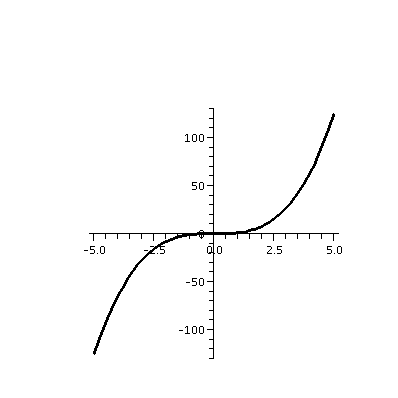
|
| The view from the x-axis
This is picture which makes life difficult. Projected only the
yz-plane, the collection of points (t2,t3) is
the same as those points satisfying y3=z2. Now
since z2 must be non-negative, any y's on this curve had
better be in the right half of the yz-plane. And for each y>0,
there are two z's (the positive and negative square roots). But the
worst part is the behavior at the origin. z=+/-y3/2 has a
horizontal tangent at (0,0): the curve has what's known as a cusp at
the origin, a type of corner. It looks sharp, not smooth!
|
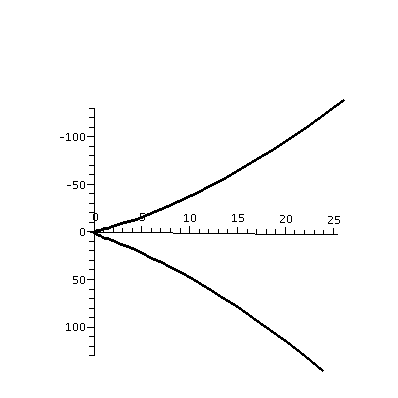
|
An oblique view
This "curve" actually does not have a corner in
three-dimensions. The pictures already shown do not make this easy to
see. To the right is sort of an oblique view of the curve as drawn by
Maple. Although this picture seems to
show a loop, the curve does not actually have any loops. The loopy
look is a result of the angle I picked. The difficulties I discussed
here are one reason the instructors would like you to be familiar with
Maple -- use of it will help your
intuition.
A perspective on real life
Frequently, similar difficulties have occurred in dissections of
bodies, when slides of different cells are prepared. Depending on the
angles of the slices, very different pictures are seen.
|
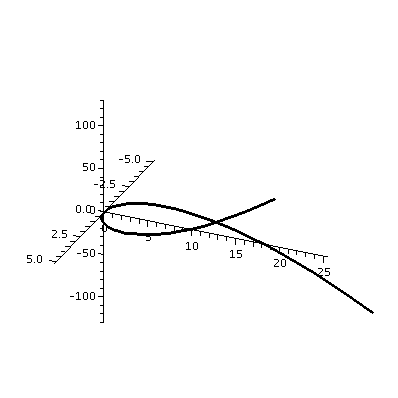
|
Robots and molecules
I also remarked that people who wanted to understand the conformation
(geometry) of biologically interesting macromolecules will need to
learn how to look at curves in R3. Also, people who want to
describe motion of robot arms necessarily need the ideas we will describe.
The derivative
If r(t)=<a(t),b(t),c(t)> is a vector function of t, we can
consider (1/h){r(t+h)-r(t)}. Inside the {} is a difference of vectors,
and that's therefore a vector. Then multiplying by 1/h: that's a
scalar multiple. So the result is a vector. It may happen that the
limit as h-->0 of this quotient may or may not exist. If it does,
we'll say that r(t) is differentiable and that the limit, which is
labeled r´(t), will be called the derivative. It is also called the
velocity vector.
It doesn't take many examples to convince yourself that the (vector)
derivative will exist exactly when all of the scalar functions a(t)
and b(t) and c(t) are differentiable, and that the components of the
resulting vector derivative will be the derivatives of these
functions. That is, if a(t) and b(t) and c(t) are differentiable, then
the vector function will also be differentiable, and
r´(t)=<a´(t),b´(t),c´(t)>. Computing the
derivative of such a vector function when the component functions are
defined by familiar formulas involves nothing essentially new. I did a
few examples.
Meaning of the derivative
The derivative balances out a large scalar, 1/h (when h is small),
with a very small secant vector, r(t+h)-r(t). That the limit
exists is rather neat fact, that somehow the shrinking of the vector
stabilizes with the increasing of the scalar amount, and that the
direction tends to a fixed direction -- this is not obvious, and one
should really not expect it!
The magnitude: speed
The magnitude of the velocity vector, ||r´(t)||, is called the
speed.
Velocity vector, tangent vector
I tried to argue, looking at a local picture of the path of a
particle, that the direction of the velocity vector is tangent to the
path of the particle. So the velocity vector is a vector
tangent to the path.
Tangent line to a helix
Look at the curve r(t)=<3cos(2t),3sin(2t),8t>. What is this?
The first two variables describe uniform circular motion. The radius
of the circle is 3, and that's the distance from the central axis of
this curve, which turns out to be a helix. The 2 changes the angular
velocity of the curve, and doubles it. The 8 affects the "pitch", the
angle of the helix, and also the distance between "loops". When 2t
changes by 2Pi, the curve passes around one loop. That means the
change in t is Pi, so the change in z is 8Pi.
 Let's find the parametric equations of a line tangent to this helix
when t=Pi/2. The line must pass through
r(2)=<3cos(2[pi/2]),3sin(2[Pi/2]),8[Pi/2]>=<-3,0,4Pi>. A
vector in the tangent direction can be gotten from the velocity
vector. So: r´(t)=<-6sin(2t),6cos(2t),8> which, when
t=Pi/2, gives <0,-6,8>. Therefore the parametric equations for
the line are:
Let's find the parametric equations of a line tangent to this helix
when t=Pi/2. The line must pass through
r(2)=<3cos(2[pi/2]),3sin(2[Pi/2]),8[Pi/2]>=<-3,0,4Pi>. A
vector in the tangent direction can be gotten from the velocity
vector. So: r´(t)=<-6sin(2t),6cos(2t),8> which, when
t=Pi/2, gives <0,-6,8>. Therefore the parametric equations for
the line are:
x=-3+0t
y=0-6t
z=4Pi+8t
To the right is a picture of both the helix and the tangent line just
specified.
Various formulas, especially product formulas
The derivative of u(t)·v(t) is
u´(t)·v(t)+u(t)·v´(t). The derivative of u(t)xv(t) is u´(t)xv(t)+u(t)xv´(t). And there's even another product
rule (multiplying a vector function by a scalar function and then
differentiating). Since the cross product is not commutative, the
order is important. We will use these formulas next time. They are
very important in describing the dynamics of motion of a point in
space.
Wednesday, September 10
I wrote a short list of properties of dot product and cross product on
the side board. I wanted a summary for use during the
lecture. Qualitatively for us, the dot product is useful for quickly
and efficiently checking when two vectors are orthogonal. As for the
cross product, for most of the course, the most important application
will be producing a vector perpendicular to a pair of vectors. We will
use both of these later in this lecture and repeatedly in the
course. The magnitude of the cross product will be used in more
advanced applications.
This course is like ...
I get confused about the meaning of metaphor and
simile. One reference I found declares
Metaphor is often confused with simile, the difference being that the
metaphor draws a parallel between concepts, while the simile points to
poetic similarities.
So I remarked in class that dot and cross product were sort of like
rivets and screws (I worked on this, darn it!) and that the whole
course was sort of like building a car. A car has thousand and
thousands (tens of thousands) of parts. We're just starting. So stay
calm. (A rivet has symmetry, fastens from both sides, and a screw has
handed-ness, just like cross product).
I did problems 15 and 28 in section 12.4 since I wanted to show some
direct examples of cross product computations.
Problem 13
What is the cross product of <(1/3),1,(1/3)> and
<-1,-1,2>? We must compute:
| i j k |
det|(1/3) 1 (1/3)|=det| 1 (1/3)|i-det|(1/3) (1/3)|j+det|(1/3) 1 |i=
| -1 -1 2 | |-1 2 | | -1 2 | | -1 -1 |
= [(1·2-(1/3)·(-1)]i-[((1/3)·2-(1/3)·(-1)]i+[((1/3)·(-1)-1·(-1)]i=(7/3)i-j+(2/3)k
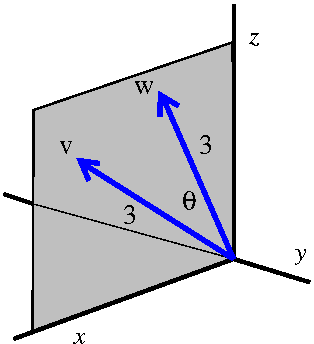 Problem 28
Problem 28
So we need to find vxw where v and w are vectors in the
xz-plane oriented as in the picture, and the angle θ between the
vectors is π/6.
As I mentioned in class, when I first glanced at this problem I
thought that there was not enough information supplied to get the
answer. But let's think.
What is the direction of vxw? Well, please try to
curl the fingers of your right hand from v to w. I think
if you do, mentally at least (I tried to show it physically in class)
the thumb of your right hand will point in the direction of the
negative y axis. The direction should be -j, a negative multiple of j.
What is the magnitude of vxw? This should be
||v|| ||w|| sine of the angle between the vectors. We are
told that this angle is π/6 which has sine equal to 1/2. And each
length is 3. So the magnitude of the cross product is (3·3)(1/2)=9/2.
The direction should be backwards in y and the magnitude should be
9/2. The cross product therefore must be -(9/2)j.
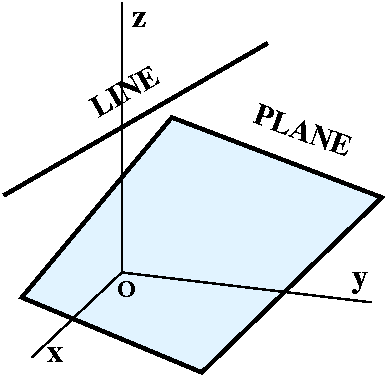
Algebraic descriptions of lines and planes
Lines are discussed in the text on pp.689-690. Planes are discussed in
section 12.5.
Mostly I think I know what a line is and what a plane is. Here
is a picture with one of both of them displayed. But what happens if
we have several of them, and we want to deal very precisely with them?
It is useful, then, to have algebraic ways of describing and computing
with lines and planes.
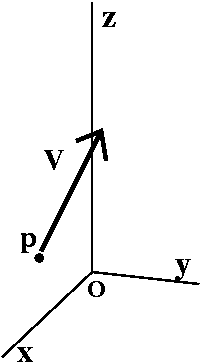 Specifying a line
Specifying a line
The following information will usually be the most convenient way to
specify a line in this course:
- A point on the line (I'll call it p)
- A vector in the direction of the line (I'll call it v)
Then the line will be everything starting out at p going forward or
backward in the direction of v. More precisely, if q=(x,y,z), then q
will be on the line if the vector pq (from p to q) is a scalar
multiple of v. This might be easier to describe with an example.
Example
If p=(3,9,5) and v=<4,-7,6>, then the vector pq will be
<x-3,y-9,z-5>. Suppose t is a scalar. The vector equation pq=tv works
out to the following three scalar equations:
x=3+4t
y=9+-7t
z=5+6t
So these are parametric equations for the straight line
determined by the data p and v. Notice where the 3 chunks of p's
information go (no t's!) and where the 3 chunks of v's information
(the direction) go (with the t's).
Other parametric representations
I then played with these equations for a while. For example, the
equations
x=3+12t
y=9+-21t
z=5+18t
represent the same line. I just multiplied the direction v by 3. This doesn't
change the actual geometric line which is parameterized by the equations: every
point in "this" line is in the other line, and, similarly, the other way
around. And
x=3-4t
y=9+7t
z=5-6t
represents also the same line: I multiplied the direction by -1 but still
we will get the same total collection of points: the same straight line. And,
perhaps more complicated:
x=7+4t
y=-2+-7t
z=11+6t
This is also the same line. Notice, please, that the direction vector
is the same, but what I have changed is the "base point",
(7,-2,11). But if you consider the original parameterization, and put
t=1 in those equations, we will get (7,2,11). So, in fact, the
descriptions sort of "overlay" one another: the v's are the same, and
the we've just happened to start the parameterizations at different
points on the same line. In the next class, we will consider in detail
the kinetic aspect of the parameterization, but right now I tell you
that the lines (the collection of all the points described by these
triples of equations) are the same.
There is a plethora of different parameterizations for the same
straight line.
Plethora officially means "A superabundance; an excess."
Symmetric equations
Some manipulation gives another way to represent the line.
x=3+4t becomes t=(x-3)/4
y=9+-7t becomes t=(y-9)/(-7)
z=5+6t becomes t=(z-5)/6
so that we have (x-3)/4=(y-9)/(-7)=(z-5)/6. Such a collection of
equations is called the symmetric form of the line. As far as I know,
we won't describe lines this way in this course.
Two points determine a line
The original work of Euclid is available, translated and illustrated,
for free on the web. You may see here.
This work has been done by Professor Joyce of Clark
University. So, way back, thousands of years ago, Euclid decided
that a line would be determined by two points. How can we use such
information to get an algebraic description?
Example
Suppose p=(3,3,-9) and q=(-5,2,1). What are parametric equations for
the line through the points p and q?
The vector pq=<-5-3,2-3,-5-(-9)>=<-8,-1,4> is a vector in the direction of the line. We could use
either p or q (I'll use p here) for a "base point"
for the line. So we get the following parametric equations for the
line:
x=3+(-8)t
y=3+(-1)t
z=-9+(4)t
The colors are an effort to show where to put the data in the
parametric formulas.
|
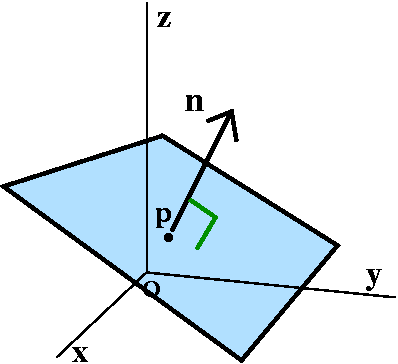 Specifying a plane
Specifying a plane
In this course, the data specifying a plane will also turn out to be a
point and a vector. What I'm about to describe may not look
immediately useful, but it will be, really. So what we will need is
- A point on the plane (I'll call it p)
- A vector
normal (perpendicular, orthogonal) to the plane (I'll call it
n)
I hope that a picture can be persuasive. There are many planes which
pass through the point p. But if you add on the requirement that, at
the point p, the vector n be perpendicular, exactly one geometric
"candidate" persists, and that's the plane I'd like to describe
algebraically.
What condition(s) on x and y and z will guarantee that q=(x,y,z) is on
the plane? Well, the vector pq should be perpendicular to n. We can
check perpendicularity easily with dot product. An example may help.
Example
Suppose p=(4,5,-7) and n is the vector <11,2,31>. The vector pq
is <x-4,y-5,z-(-7)> and pq is perpendicular to n exactly when pq·n=0. And that is
11(x-4)+2(y-5)+31(z-(-7))=0
This is a fine equation. You don't need to "clean it up". Of
course, it can be rewritten (if you must!) as
11x+2y+31z=44+10-217=163.
Again, there are many equivalent equations for one geometric plane
since there are lots of vectors normal to one plane, and lots of
points on one plane. And we can do the reverse:
Reversing ...
6x+-3y+7z=20 is the equation of a plane.
What is a vector normal to this plane? If you
followed the previous discussion, I hope you can see that the
components of such a vector are the coefficients of x and y and z in
order. So n=<6,-3,7> is a vector normal to this plane.
What are all (non-zero) vectors normal to this plane? These vectors
are the non-zero scalar multiples of <6,-3,7>.
What are the coordinates of a point on the plane 6x-3y+7z=20?
Part of the problem in answer this question is that there are so
many possibly answers! For example, (0,0,20/7) is one answer, and
so is (1,-7/3,1), and so is .... uhhh ... (1,000, -1,000,
-8,980/7). There are many points on the plane.
Three points determine a plane
Again, Euclid declared that 3 points in space should determine a
plane. So can we find an algebraic description of a plane through
the points p=(3,3,-9) and q=(-5,2,1) and r=(4,2,2)? We need to find a
vector n normal to the plane. Well, the vectors pq and (say) qr are in
the plane's direction. The cross-product of these two vectors will be
perpendicular to the plane. So: pq=<-8,-1,4> and qr=<9,0,1>, and
| i j k |
det|-8 -1 4 |=-i-(-8-36)j-(-9)k=-i+44j+9k
| 9 0 1 |
is a normal vector. So -1(x-3)+44(y-3)+9(z-(-9))=0 is an equation of this
plane. (We would get equivalent equations if we used q or r instead of p, or
if we computed with pqxpr instead of pqxqr.)
|
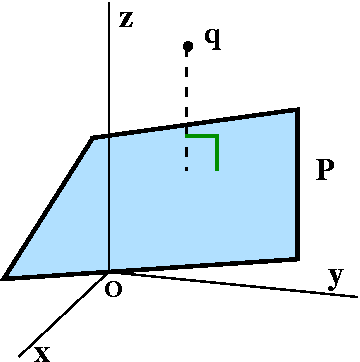 Distance of a point to a plane
Distance of a point to a plane
Suppose the point q is not on a plane, P. How can we find the
distance from q to P? I did this in a rather clumsy way in class,
mostly because I wanted to practice how to use line and plane
equations. Let me start with specific information:
Suppose
q=(2,1,3) and P is the plane specified by the equation
5x-7y+6z=10.
First, is q on the plane, P? Well, we can check this by substituting
the coordinates of q into the equation presented for P:
5·2-7·1+6·3=10-7+18=21, and 21 is not 10, so q is
not on P.
My strategy for finding the distance was to write the parametric
equations for a line through q perpendicular to P, see where the line
intersected P, and then compute the distance from q to that point. So
let me try to carry this out.
A line perpendicular to P through q Well, n=<5,-7,6> is a
vector normal to P. So
x=2+5t
y=1-7t
z=3+6t
are parametric equations for the desired line.
The intersection of the line and the plane Take the
parametric equations and plug them into the equation for the line:
5x-7y+6z=10 becomes 5(2+5t)-7(1-7t)+6(3+6t)=10 which is
(25+49+36)t=10-10+7-18 and this is 110t=-11 so t=-11/110=-1/10.
What does this value of t mean? It is the value of t which, when
substituted in the parametric equations, gives the intersection
point. So:
x=2+5(-1/10)=15/10
y=1-7(-1/10)=17/10
z=3+6(-1/10)=24/10
The intersection point is (15/10,17/10,24/10).
The distance between q=(2,1,3) and the intersection point
This is
sqrt{(2-15/10)2+(1-17/10)2+(3-24/10)2}. This
is sqrt(25+49+36)/10=sqrt(110)/10.
Another way ...
There are frequently different and equally valid solution strategies.
Here is another way to do this problem: (2,1,3) is not on the plane
5x-7y+6z=10. I can find a point on the plane just by "guess" (as I did
earlier, and I will guess for something convenient!): r=(2,0,0). Then
the vector rq=<0,1,3> points from the plane to q. Now if I project rq
onto the normal vector I will get a vector whose length is the
distance from the plane to the point. This "projection" is just what I
did last time when I found the parallel part of a
vector. So n=>5,-7,6> is still a vector normal to the plane. So we
just compute rq·n/||n||=(-7+18)/sqrt{110}=11/sqrt{110},
which is the same answer. This is more direct and more efficient.
The following material was not done in class but maybe showing you
some examples will help you with homework.
Parallel lines
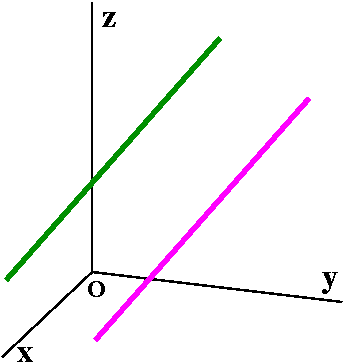 I guess two lines are parallel if they are distinct (that is,
separate lines!) and if their directions are non-zero multiples of one
another. So, for example, the lines
I guess two lines are parallel if they are distinct (that is,
separate lines!) and if their directions are non-zero multiples of one
another. So, for example, the lines
Line A Line B
x=5+t x=30+t
y=3+2t y=-9+2t
z=-1+3t z=-1+3t
are parallel. Well, certainly their directions are multiples of one
another (the multiple is 1). But why are they "distinct"? The point
(5,3,-1) is on the first line. For it to be on the second line, uhhh ...
30+t=5, so t=-25. The second equation is then y=-9-(2)25=-59, and this is
not 3. So (5,3,-1) is not on the other line.
These are parallel lines.
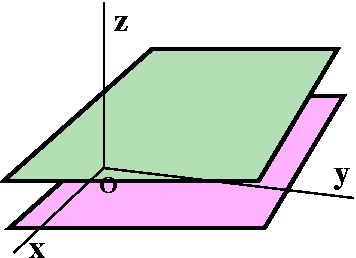 Parallel planes
Parallel planes
Two planes are parallel if they are distinct (that is, separate
planes!) and their normal vectors are non-zero multiples of one
another. For example, 2x+3y-z=56 and 4x+6y-2z=10 are parallel. Double
the first equation and get the right-hand side of the second: that
shows their normal vectors are non-zero multiples (the multiple is
2). But since twice 56=112 is not the same as 10, these planes are
definitely distinct: different.
Skew lines
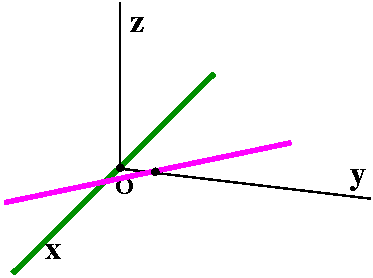 As dimensions increase, generally geometry gets more complicated. One
phenomenon which does not occur in two dimensions is skew
lines. A pair of lines is skew if they are not parallel and
also do not intersect. So look at, say, the x-axis (where parametric
equations could be x=t,y=0,z=0) and a line through (0,1,0) which is
tilted with respect to the x-axis: x=t,y=1,z=t. These lines don't
intersect since no point with second coordinate 0 is on the second
line. They aren't parallel since <1,0,0>, the direction of the first
line, is not a non-zero scalar multiple of <1,0,1>. So they are skew.
As dimensions increase, generally geometry gets more complicated. One
phenomenon which does not occur in two dimensions is skew
lines. A pair of lines is skew if they are not parallel and
also do not intersect. So look at, say, the x-axis (where parametric
equations could be x=t,y=0,z=0) and a line through (0,1,0) which is
tilted with respect to the x-axis: x=t,y=1,z=t. These lines don't
intersect since no point with second coordinate 0 is on the second
line. They aren't parallel since <1,0,0>, the direction of the first
line, is not a non-zero scalar multiple of <1,0,1>. So they are skew.
Things get even worse as n, the dimension, increases. For example, it
is possible to have pairs of skew planes (two dimensional
objects) in R4.
Intersection of two planes
The two planes 3x-y=4 and 2x-2y+z=1 are not parallel. They intersect
in a line. How can we get parametric equations for this line?
The planes are not parallel because the normal vectors (<3,-1,0> and
<2,-2,1>, respectively) are not scalar multiples of one another. A
vector in the direction of the line will be perpendicular to both of
these normal vectors. The cross product gives us such a vector:
<3,-1,0>x<2,-2,1> is -i-3j+4k. We also
need a point on both planes. Well, if z=0 then we must find x and y
which satisfy both 3x-y=4 and 2x-2y+0=1. I can do this: double the
first equation and subtract the second equation. The result is 4x=7,
so x=7/4 and then the first equation becomes 3(7/4)-y=4 so y=5/4. And
(7/4,5/4,0) is a point on the line. Therefore a set of parametric
equations for the line is
x=7/4+-t
y=5/4+-3t
z=0+4t.
Parametric equations for a plane
Another way to describe a plane is parametrically. Pick a point
on the plane, and pick two vectors with distinct directions pointing
in the plane. Wait: let's look at an example. Suppose the plane
contains the point p=(9,-5,1) and the vectors u=<3,-2,5> and
v=<6,5,4> point along the plane. Then for all numbers s and t,
the points described by (9,-5,1)+su+tv describe a plane. I can break
this up into components:
x=9+3s+6t
y=-5-2s+5t
z=1+5s+4t
We will deal with this alternative algebraic description of planes
later when we discuss parametric surfaces. We can get back a
vector normal to the plane by taking the cross product of u and v.
|
Monday, September 8
What's on the web and why?
I discussed the material I would place on the web for this course. I
called attention to the list of
students. Please check your entry. I urged in class and I urge
readers now to consider forming a study group for Math 251: do
homework problems together, prepare for exams, etc. There is
considerable evidence that students who work in study groups
learn more and get higher grades.
The easy (?) product
Suppose v=ai+bj+ck=<a,b,c> (the text uses these angle brackets,
and I will try to use them but probably I will get excited and replace
them with ordinary parentheses once in a while) and w=di+ej+fk. Then
I'll define the dot product or the scalar product or the inner product
(all of these phrases are used but I will mostly use "dot product") of
v and w to be the number
ad+be+cf. Our notation for this will be
v·w. Some textbooks use (v,w) or
<v,w>.
This doesn't look too impressive, but it turns out to occur enormously
frequently in many applications (so many, as I mentioned in class,
that most computer languages have devoted special attention to how to
evaluate it rapidly, and, indeed, the chips of many CPU's have special
"microcode" to evaluate inner products efficiently). Why would such
things occur in "real life"?
The farmer's market
New Jersey is the
Garden State. In the summer and early fall, almost every Friday I
go to a local farmer's market and buy fresh New Jersey fruits and
vegetables. So the task facing the cashier when I come up, hands full
of stuff, is to figure out what I owe. The logic of the cost
computation might be tabulated as follows:
| Type of purchase | Apples | Eggplant | Garlic | Onions | Peppers | Potatoes | Zucchini |
|---|
| Price per pound | $1.50 | $1 | $2.50 | $1.25 | $1.50 | $1 | 75¢ |
|---|
Weight of item
in pounds | 3 | 1.2 | .3 | 4 | 2 | 5 | 1.2 |
|---|
Now really look at the table. If you compute the total cost,
you'd better not confuse the order of the items. Each row has an
7-tuple of numbers: this is an element of R7. Let's call
the second row the cost vector, C, and the third row
will be the weight vector, W. What will the total cost
of this lovely purchase? Clearly it is
C·W dollars:
(1.5)(3)+(1)(1.2)+(2.5)(.3)+(1.25)(4)+(1.5)(2)+(1)(5)+(.75)(1.2).
I'm not particularly interested in the number, more in the logic.
A hobby or two?
Everyone should have a hobby, something silly to occupy their time
when they should be working. One of my hobbies, since I started
teaching calculus, is to go through a day and try to identify every
use of the derivative idea. There are lots and lots of them. Another
hobby, perhaps even more fruitful (pun intended!) is to identify every
darn use of inner product in a typical day. There are many uses. But I
am supposed to concentrate on three dimensions, so let's get back to
work.
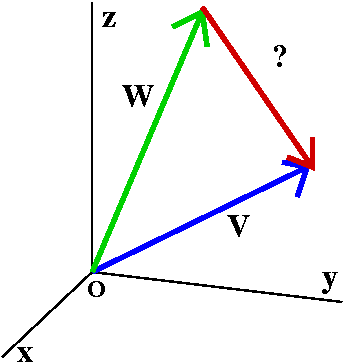 Looking at lengths again
Looking at lengths again
Start with v=ai+bj+ck so that
||v||=srqt{a2+b2+c2}. If w=di+ej+fk,
then ||w||=srqt{d2+e2+f2}. If I draw
the vectors v and w with their tails on the origin, then a vector,
identified in the picture with "?", completes a triangle, going from
the head of w to the head of v. Well, that vector isn't too
mysterious. I know that w+?=v, so ?=v-w. In terms of components, we
can write v-w=(a-d)i+(b-e)j+(c-f)k. The length of v-w is
sqrt{(a-d)2+(b-e)2+c-f)2}. You can
check easily that the length of v-w and the lengths of v and w are not
related in any simple way.
Really the squares of the lengths
With all the square roots, maybe we should be looking at the squares
of the lengths. Also the algebra will be easier!
Then
||v||2=a2+b2+c2
and
||w||2=d2+e2+f2
and
||v-w||2=(a-d)2+(b-e)2+(c-f)2.
We can "expand" the last term to get
||v-w||2=a2-2ad+d2+b2-2be+e2+c2-2cd+e2.
That is exciting.
The obstacle to making it work
Well, if you compare terms, the sum
||v||2+||w||2 is the same as ||v-w||2
except for -2ad-2be-2cf=-2(ad+be+cf). So computations with lengths and
squares of lengths will have to include that "mess". Let me forget the
-2, which isn't that essential. What an accident: the obstacle to
making things ridiculously simple is (essentially) the dot product.
Color change?
I'll write material with this background color if I just did not have
time to disucss it in class but if I think it is useful enough that
students might profit from seeing it.
The dot product and its basic properties
If v=ai+bj+ck and w=di+ej+fk, then v·w=ad+be+cf.
The dot product obeys the following rules.
- If v and w are vectors then v·w is a
scalar (in this course this means "a real number").
- (Commutativity) v·w=w·v. (You can see this is correct by
looking at the pieces of v·w and
w·v. For example, ad is the same as
da.)
- (Linearity or distributivity of vector addition over scalar
multiplication) (v1+v2)·w=(v1·w)+(v2·w). (Again, you can check that this is
correct by doing algebra with the components. A similar statement is
true about the second factor, sice dot product is commutative.)
- v·0=0.
- v·v=||v||2.
Example with a little table
Suppose we have four rambunctious ("Boisterous and disorderly")
vectors: v1 and v2 and w1 and
w2. Suppose also we have this little multiplication
table for their dot products:
· | w1 | w2
--------------
v1 | 3 | 7
--------------
v2 | 4 | -2
Could we then compute something like
(4v1-3v2)·(5w1-2w2).
Here I would expect people to distribute or take advantage of linearity on
both the left- and right-had sides. The process might
go like this:
(4v1)·(5w1-2w2)+(-3v2)·(5w1-2w2)
(4v1)·(5w1)+(4v1)·(-2w2)+(-3v2)·(5w1)+(-3v2)·(-2w2)
(4·5)v1·w1+(4·-2)v1·w2+(-3·5)v2·w1+(-3·-2)v2·w2
(4·5)(3)+(4·-2)7+(-3·5)(4)+(-3·-2)(-2)
And the answer seems to be .... 60-56-60-12=-68. I think this is
correct. I make more errors in such computations when no one is
watching me.
|
The law of cosines lurks ...
There's a formula which generalizes the Pythagorean Theorem's
formula. For the triangle shown above, here it is:
||v-w||2=||v||2+||w||2-2||v|| ||w||cos(theta)
Here theta is the angle opposite the side v-w. If theta is Pi/2, the
cosine term is 0 and we get back Pythagoras. Here is the geometric view of the areas of
the squares on the sides of a triangle.
The geometry of the dot product
Since we know that
||v-w||2=||v||2+||w||2-2||v|| ||w||cos(theta)
and we know that
||v-w||2=a2-2ad+d2+b2-2be+e2+c2-2cd+e2=||v||2+||w||2-2v·w. We
see that (cancelling the -2's)
v·w=||v|| ||w||cos(theta) where theta is the angle between v and w.
Notice that we can now see if v and w are not 0, then v and w are
orthogonal (perpendicular, normal) exactly when v·w=0.
Determining an angle
Suppose v=<3,2,-1> and w=<5,2,6>. What is the angle between v and w?
Well, v·w=15+4-6=13, ||v||=sqrt(14), and ||w||=sqrt(65). Therefore
cos(theta)=13/[sqrt(14)sqrt(65)]. This gives approximately
(calculator-assisted computation here!) 64.55 degrees or (better, I
guess) 1.126 radians.
Resolving a vector into perpendicular and parallel parts
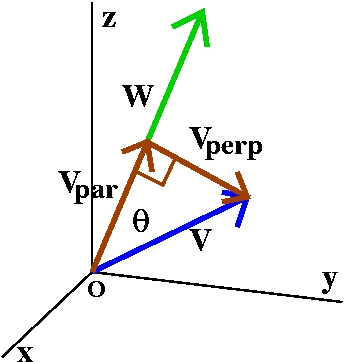 Let me continue using the v=<3,2,-1> and w=<5,2,6> from the previous
question. I'd like to show you how to write v as a sum of two
vectors, v|| and v⊥ where v⊥
is perpendicular to w and v|| is parallel to w. This will
be useful several times in the course, and is also important in
physics.
Let me continue using the v=<3,2,-1> and w=<5,2,6> from the previous
question. I'd like to show you how to write v as a sum of two
vectors, v|| and v⊥ where v⊥
is perpendicular to w and v|| is parallel to w. This will
be useful several times in the course, and is also important in
physics.
How long is v||? If you look at the picture, the
v|| is part of a right triangle. It is the adjacent leg and
v is the hypoteneuse. Theta is the angle between them. Therefore
||v||||=||v||cos(theta)=v·w/||w||. We did some of these
computations just above, so ||v||||=13/sqrt(65). How can we
get the correct direction? So we want a vector whose length is
13/sqrt(65) and whose direction is the direction of w. Well, we can
create a unit vector (a vector of length 1) in the direction of
w: that will be w/||w|| which is <5,2,6>/sqrt(65). And now we adjust
this unit vector by stretching it, to get
[13/sqrt(65)]<5,2,6>/sqrt(65). This is about all I did in class, but
let me finish things here. The vector is
(13/65)<5,2,6>=<1,26/65,78/65>. Since
v=v||+v⊥, we know that
v⊥=v-v||=<3,2,-1>-<1,26/65,78/65>=<2,104/65,-143/65>.
Checking the answer
Well, v⊥ should be perpendicular to w. So let's
compute v⊥·w=<2,104/65,-143/65>·<5,2,6>=10+(208/65)-(859/65)=(650+208-858)/65=(858-858)/65=0,
so these vectors are indeed orthogonal.
Comment I admit (informative to you and irritating to me) that
I did all these computations by hand, and I had to do them three
times to get them to come out correctly.
Another product, introduced geometrically
I defined the dot product by a rather simple algebraic formula. The
cross product has a complicated algebraic formula, and maybe it is
easier to beguin by defining it geometrically.
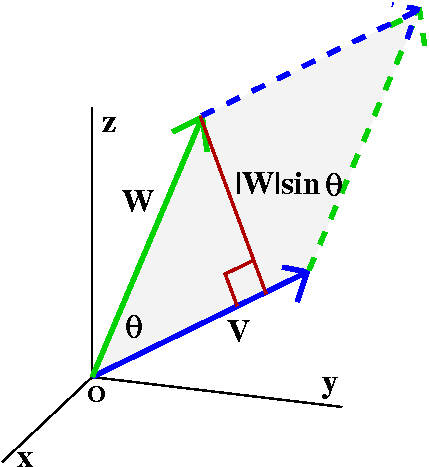
The cross product (also called the vector or outer product) takes two
vectors, v and w, and produces vxw, another vector. Since this is a
vector, it is specified by its magnitude and direction.
Magnitude of vxw
Look at the the vectors v and w. There is a parallelogram which has
sides v and w. The area (a non-negative quantity) of that
parallelogram is the magnitude of vxw.
I forgot to say in class that there is an easy formula for the area in
terms of the lengths of the vectors and the angle between them. The
area is ||v|| ||w||sin(theta). You get this by mulitplying the base
by the altitude in the plane of the parellelogram.
Direction of vxw
 Take your right hand and extend your
thumb. Curl up your fingers. Insert your hand (I guess by though, not
physically) so that your fingers go from v to w. Then
your thumb will be (sort of) pointed perpendicular to the plane
containing v and w. That perpendicular direction is the direction of
vxw.
Take your right hand and extend your
thumb. Curl up your fingers. Insert your hand (I guess by though, not
physically) so that your fingers go from v to w. Then
your thumb will be (sort of) pointed perpendicular to the plane
containing v and w. That perpendicular direction is the direction of
vxw.
The only reason that such a weird product would be considered is that
it is useful. We will see some geometric uses of it in this course and
most of you will see uses in mechanics (torque), eletromagnetism, etc.
The i,j,k multiplication table
So before anyone could yell too much I computed the cross product
"multiplication table" for i and j and k.
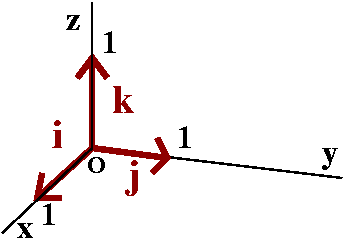 This wasn't too hard,
although getting the directions correct involved some thought
and some physical contortions. These are unit vectors and all mutually
perpendicular. If the vectors in the product are the same, then the
parallelogram involved collapses to a line segment and has no area. If
the vectors are different, then the parallelgram is a square with 1
unit sides, and has area 1. The important thing is the sign of the
answer and its direction. I tried to get that correct. If you were not
in class or you were confused, I urge you to try to get some of the
entries in this table yourself.
This wasn't too hard,
although getting the directions correct involved some thought
and some physical contortions. These are unit vectors and all mutually
perpendicular. If the vectors in the product are the same, then the
parallelogram involved collapses to a line segment and has no area. If
the vectors are different, then the parallelgram is a square with 1
unit sides, and has area 1. The important thing is the sign of the
answer and its direction. I tried to get that correct. If you were not
in class or you were confused, I urge you to try to get some of the
entries in this table yourself.
x | i | j | k
--------------------
i | 0 | k | -j
--------------------
j | -k | 0 | i
--------------------
k | j | -i | 0
Weird stuff
Things to notice:
ixj=k and jxi=-k. The cross product is not necessarily commutative.
(ixj)xj=kxj=-1 and ix(jxj)=ix0=0. The cross product is not
necessarily associative.
This means that you can't necessarily rearrange or regroup cross
products. This is annoying. The cross product does not resemble many
other products you have seen.
Then the cross product in terms of components is ...
I then did the following awful computation, which you should never do:
If v=ai+bj+ck and w=di+ej+fk, then vxw=
(ai+bj+ck)x(di+ej+fk)=ad(ixi)+ae(ixj)+af(ixk)+bd(jxi)+be(jxj)+bf(jxk)+cd(kxi)+ce(kxj)+cf(kxk).
I filled in all the values from the multiplication table above and got
the following mess:
vxw=ad(0)+ae(k)+af(-j)+bd(-k)+be(0)+bf(i)+cd(j)+ce(-i)+cf(0)=(bf-ce)i+(cd-af)j+(ae-bd)k
|
This last formula can be expressed in a very neat way if you know about determinants.
It turns out that
| i j k |
vxw=det| a b c |
| d e f |
here's a very brief discussion of determinants in the textbook. I
will probably evaluate this determinant most of the time by "expanding
along the first row" but you may use any valid method.
Why is what I've done correct?
The definition I gave for cross product was geometric. Some of the
properties of cross product are easy from the geometric
definition. But I've just used linearity (or distributed the sum over
the cross product), something like this:
(v1+v2)xw=(v1xw)+(v2xw). Why is this true? This is not clear (!) to me at all from the
geometric definition. Here
is a paper which shows why you can distribute using geometry. Figure 8
on page 9 of this paper is a picture which should convince (is
supposed to convince) you that cross product does have the desired
algebraic property. I hope you will find it convincing. I find it
difficult to really understand.
|
Wednesday, September 3
What is this?
This is Math 251. The lectures will be done by me, and I will attempt to
stay awake enough to give moderately understandable presentations at
the incredibly late hours that these sections meet. My brain only
really functions well much earlier in the day. Mr. Dibble will teach
the recitations.
Who am I?
I'm a faculty member in the Rutgers Math Department. Much of my
professional work has involved differential equations involving
functions of more than one variable. I actually like the
content of this course, and I may get almost incoherent with
excitement and pleasure when describing some of the subject
matter. Certainly I will draw pictures that seem to mean something to
me, but they may be totally incomprehensible to almost everyone
else. I apologize in advance.
Diary
I will try to write a diary for this course, since some
students have told me it is helpful. I am teaching an extra course
this semester, so I don't know how much time I will have. I will use
lots of material from the diary I wrote the last time I taught
251. This is not "plagiarism". I wrote the material, I acknowledge
using it, and I've given myself permission. For your information, it
isn't usually the text that takes much time, but rather the darn
pictures. Lots of time is needed to create good pictures!
Who are you?
Most of the students in these sections are
engineering students. Many engineering students (especially in
Mechanical, Chemical, and Biochem) will go on to take Math 421 where
all the material of this course is used. Other students are from such
disciplines as chemistry, computer science, mathematics, meteorology,
and physics. Certain biological science majors take this course,
principally because they will take physical chemistry, and the
language of several variable calculus is essential in
pchem. Additionally, some students may be in this class for "fun" (if
that's possible) but may be interested in a business career. It turns
out that there's a huge developing field of mathematical finance and
the ideas of this course are, again, essential tools.
What will we study?
I tried to briefly discuss the background of the
course. The link indicated has more information.
Then we went on to "review" analytic geometry of one and two and even
three dimensions. I put the word in quotes because most students who
have taken courses in applied science and engineering have already
seen the material we will discuss in 2 or 3 or even 4 other courses!
The poor math majors may never have seen this before so they
especially should read the text.
R1
 This is supposed to be the real line. There's an origin and a
unit length, and the conventional choice is to make the positive
direction go off to the right. Each point on the line corresponds to a
real number. The distance between points on the line which correspond
to the real numbers a and b is defined to be |a-b|.
This is supposed to be the real line. There's an origin and a
unit length, and the conventional choice is to make the positive
direction go off to the right. Each point on the line corresponds to a
real number. The distance between points on the line which correspond
to the real numbers a and b is defined to be |a-b|.
R2
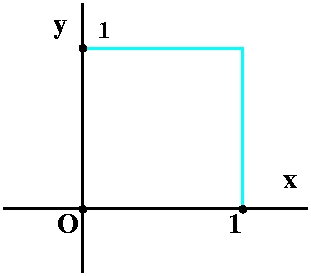 And here is the plane (I don't think I've ever heard anyone
call it the "real plane"). The simplest situation is what's shown
here. Two straight lines as axes, perpendicular to each. Every point
corresponds to a unique ordered pair of real numbers. There is a set
unit length on each coordinate axis, and almost always right is
positive and up is positive. Later in the course we will consider
situations where the coordinate axes are not necessarily
perpendicular. And even where what corresponds to the axes are not
straight. I hope that tilted axes could make sense if, for
example, you were interested in looking at crystals which did not have
rectangular symmetry.
And here is the plane (I don't think I've ever heard anyone
call it the "real plane"). The simplest situation is what's shown
here. Two straight lines as axes, perpendicular to each. Every point
corresponds to a unique ordered pair of real numbers. There is a set
unit length on each coordinate axis, and almost always right is
positive and up is positive. Later in the course we will consider
situations where the coordinate axes are not necessarily
perpendicular. And even where what corresponds to the axes are not
straight. I hope that tilted axes could make sense if, for
example, you were interested in looking at crystals which did not have
rectangular symmetry.
R3
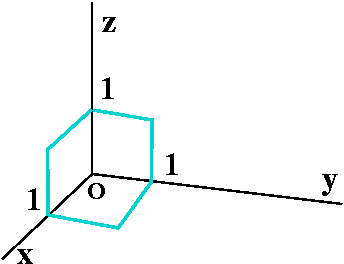 In three dimensions, the geometric situation is specified by three
mutually perpendicular lines. Points will correspond to ordered
triples of real numbers. In almost every situation you are likely to
encounter, these axes will be right-handed. Right-handed means
... means ... means ... well, it means what I sketched to the right
(heh heh). The three dimensional world is complicated, and you will
see that the choice of right-handedness has some interesting
consequences.
In three dimensions, the geometric situation is specified by three
mutually perpendicular lines. Points will correspond to ordered
triples of real numbers. In almost every situation you are likely to
encounter, these axes will be right-handed. Right-handed means
... means ... means ... well, it means what I sketched to the right
(heh heh). The three dimensional world is complicated, and you will
see that the choice of right-handedness has some interesting
consequences.
Chirality or handedness
A discussion of Chirality is linked.
Here is a short
discussion of parity in chemistry and physics. And here is a Wikipedia
article on enantiomers, which are compounds that are
non-superimposable mirror images of one another. This article is a bit
more technical, but has many examples of pharmaceutical products which
are mirror images.
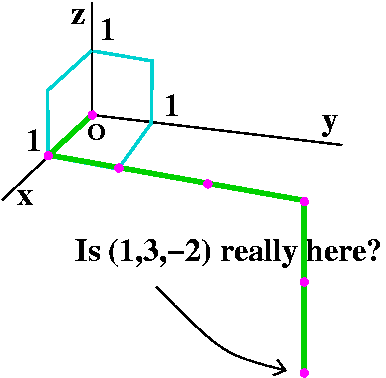 Perilous pictures
Perilous pictures
Here is my attempt to draw the point with coordinates (3,2,-1).
The green "path" with  's sort of tells how to find the
point. I walk (?) from (0,0,0) to (1,0,0), then to (1,3,0), and
finally to (1,3,-2). Each
's sort of tells how to find the
point. I walk (?) from (0,0,0) to (1,0,0), then to (1,3,0), and
finally to (1,3,-2). Each  is
supposed to represent one unit of the path. I think that the
complications of perspective and reducing the "object" from three
dimensions to a two-dimensional representation may make even such a
simple picture difficult to understand. If you weren't told that the
point was supposed to be (1,3,-2), would you have guessed those were
the coordinates? Sigh.
is
supposed to represent one unit of the path. I think that the
complications of perspective and reducing the "object" from three
dimensions to a two-dimensional representation may make even such a
simple picture difficult to understand. If you weren't told that the
point was supposed to be (1,3,-2), would you have guessed those were
the coordinates? Sigh.
I will try to draw good pictures, but I won't always
succeed. And even if I draw pictures which I believe are suitable, you
may well not agree. Pictures are complicated.
Some simple geometry and equations
What points in R3 have y=2? Certainly (0,2,0), on
the y-axis, is the only point on the y-axis with y=2. We can move up
and down (changing z-coordinate) and sideways (changing
x-coordinate). We can even change both. The collection of points we
get is a plane, perpendicular to the y-axis through the point
(0,2,0). An attempt at a picture is to the right. You don't need to
agree that this is a good picture.
In this course I will probably regard the following technical words as
synonymous (the words mean the same) most of the time:
perpendicular
orthogonal normal
|

|
|
What points in R3 have z<5? This is a an open
half-space. The plane z=5 is the boundary of this region and
the region does not include the boundary. Later in the course I'll try
to discuss the use of "open" and "boundary" in more detail. Here the
boundary is a plane normal to the z-axis through the point
(0,0,5). The plane, however, is not included in the region
specified by z<5. What I've attempted to show in
the picture is an open half-space.
|
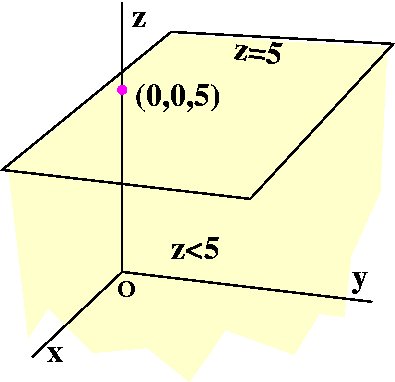
|
| Let's imagine a brick in R3 with its
sides parallel to the xy and yz and xz planes. Maybe this could be
called a right-angled parallelopiped. Suppose one corner (also called
a vertex) has coordinates (a,b,c) and the diagonally opposite corner
has coordinates (d,e,f).
|
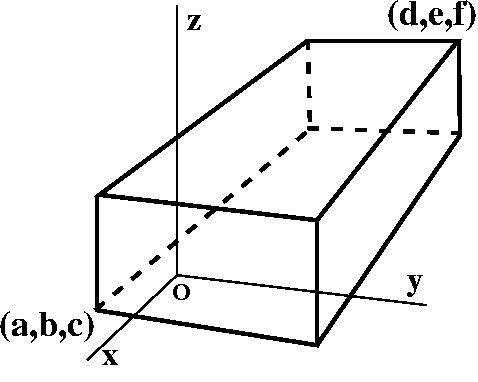 |
Suppose now we look at the corner displayed in the
accompanying picture, the corner illustrated with  . What are the coordinates of that
point? . What are the coordinates of that
point?
If you can "see" what the picture is supposed to show, then the
designated corner is just moved "out" parallel to the direction of the
y-axis. The x-coordinate doesn't change at all, and the height from
the xy-plane (which is the z-coordinate) also doesn't change.
Therefore the coordinates of  are
certainly (a,?,c). What about the second coordinate of the
point? If you look at the picture with me, you can see that the entire
face or side of the solid between are
certainly (a,?,c). What about the second coordinate of the
point? If you look at the picture with me, you can see that the entire
face or side of the solid between  and the point (d,e,f) has constant y-value: it is
perpendicular to the y-axis. Therefore the mystery middle coordinate
must be the same as the middle coordinate of (d,e,f), and so and the point (d,e,f) has constant y-value: it is
perpendicular to the y-axis. Therefore the mystery middle coordinate
must be the same as the middle coordinate of (d,e,f), and so
 =(a,e,c). =(a,e,c). |
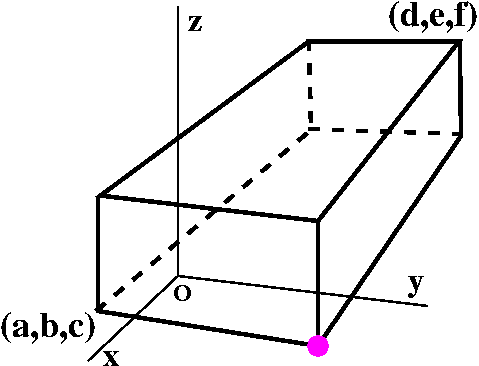 |
Now let us play the same game with another vertex (or
corner). So the designation of  has been moved to the corner shown. What are the coordinates of this
point? This point is on the same face or side of the solid so it
certainly shares the second or y-coordinate with both (d,e,f) and
(a,e,c), so
has been moved to the corner shown. What are the coordinates of this
point? This point is on the same face or side of the solid so it
certainly shares the second or y-coordinate with both (d,e,f) and
(a,e,c), so  =(?1,e,?2). Well, the
third coordinate, ?2, must be c since the point
we're looking at is certainly on the bottom face of the solid. The
first coordinate might be the most puzzling, but both (d,e,f) and =(?1,e,?2). Well, the
third coordinate, ?2, must be c since the point
we're looking at is certainly on the bottom face of the solid. The
first coordinate might be the most puzzling, but both (d,e,f) and  are on the "back" face (that is part
of the plane x=d) of the solid, so the x-coordinate we're looking for
is d. Therefore this are on the "back" face (that is part
of the plane x=d) of the solid, so the x-coordinate we're looking for
is d. Therefore this  is (d,e,c). is (d,e,c).
A good exercise for you is to figure out the coordinates of
some of the other corners of the brick.
|
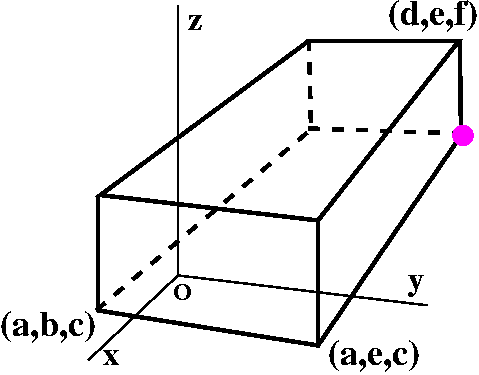 |
| Now I'd like to compute the length of some of the edges of the
brick. For example, what is the length of the line segment connecting
(a,b,c) and (a,e,c)? This is the distance between these two
points. Notice that the only coordinate which is varying is the middle
one. This side is a line segment which is parallel to the y-axis. We
can measure length along it only by thinking about the
one-dimensional distance between b and e. That distance is |b-e|. The
reason for the absolute value signs is that distance is supposed to be
non-negative.
|
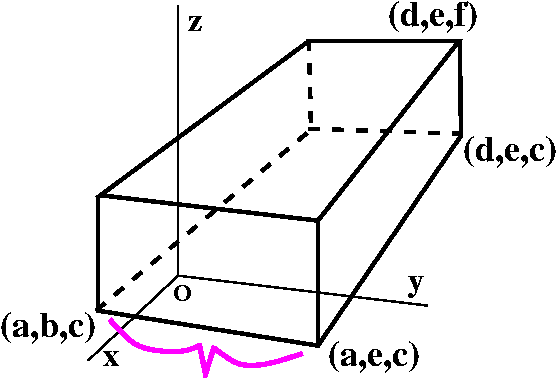
|
| We can try to do the same thing with the edge connecting the
points with coordinates (a,e,c) and (d,e,c). Here the only coordinate
difference is in the first, x-, coordinate. So distances again should
be measured as if they were in one dimension, along the parallel
x-axes. The distance we want is |a-d|.
|
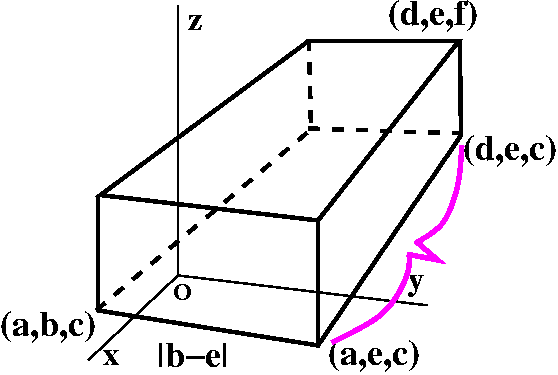
|
Now we can be even more bold. (Well, bold for a math class.)
We can find the distance from (a,b,c) to (d,e,c). Well, look carefully
and see that there is a right triangle whose hypotenuse is the
distance wanted, and whose "legs" have distances we already know. Then
Pythagoras declares that the length of the hypotenuse is
sqrt(|b-e|2+|a-d|2)
If
you are somewhat alert this result is not too surprising. The bottom
face of this brick is where z=c. The formula written is just the
ordinary two-dimensional distance between the points (a,b) and (d,e).
|
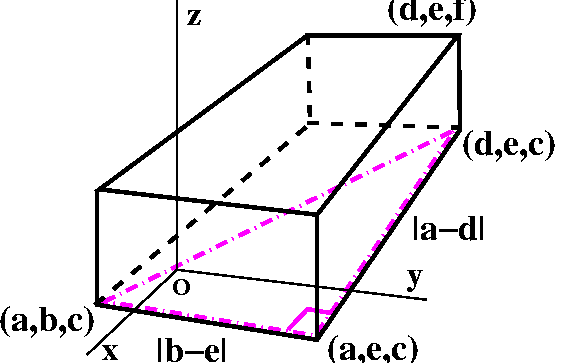
|
I'm not going to try to put that formula in the picture. I
will just label the distance Blah. Now I want the distance
along one of the main diagonals of the brick, from (a,b,c) to
(d,e,f). There is, as shown, another right triangle. The hypotenuse is
the distance I want, and the two legs have distances we know: one is
Blah and the other is ... the other is: well, the same ideas as
before (since the endpoints differ in only one coordinate) tell me
that the distance is |c-f|. Therefore (again Pythagorus) the
distance between the farthest apart corners is
sqrt(Blah2+|a-d|2)
But let me write it out in all of its glory (or gory [details, that is!]):
|
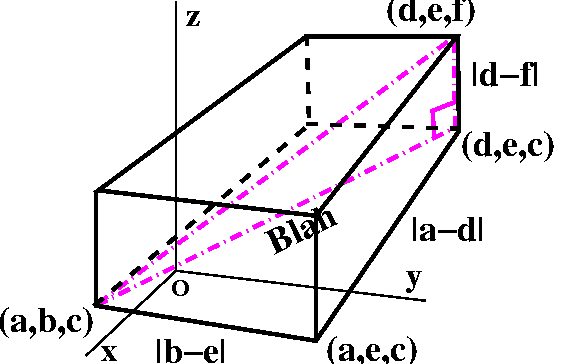 |
sqrt({sqrt(|b-e|2+|a-d|2)}2+|a-d|2)
Here I inserted the formula we previously got for Blah. But
lots of what is written in this formula is superfluous. The square of
a square root is always the number. We don't need absolute values if
we are square a number. So therefore we can make a spontaneous (!)
definition:
The Euclidean distance
The (Euclidean) distance between (a,b,c) and (d,e,f) is sqrt((a-d)2+(b-e)2+(c-f)2).
A bunch of comments
First, math definitions shouldn't (and generally aren't) written at
random. They ideally should be supported by examples and
"intuition". Here the word intuition really means looking at lots of
situations and extracting the important common ideas.
In this course you'll observe an enormous storm of
definitions. Almost all of them are not motivated by anything
resembling "theoretical" considerations. The definitions were created
to help discuss various real physical and geometrical situations. So
the fact that the math is widely used in so many applications is not
an accident -- it was arranged that way!
Second, the definition actually shows you how to define distance
between points in R17, if you would ever want to. The
definition should be something like the square root of the sum of the
squares of the differences between the respective coordinates of the
points. And this actually (for many purposes) is a good definition.
The distance between two points is 0 exactly when the points are the
same, and the distance between p and q is the same as the distance
between q and p. Math majors who have taken Math 300 might recognize
the skeleton of a definition using mathematical induction. But I can't
talk about this here.
I remark that the distance defined is called the Euclidean
distance because there are other ways of defining "good" distances,
and some of them are useful in other contexts. For example, students
who study digital signal processing will find out that the Euclidean
distance is perhaps not always the most useful distance when comparing
signals. In this course, the Euclidean distance will be the only one
used, so I will almost always omit the adjective "Euclidean". What is
nice about the Euclidean distance, though, is that it is very
computationally neat, and leads to the method of least squares, which
is a very commonly used method of fitting "curves" (function
descriptions) to data points.
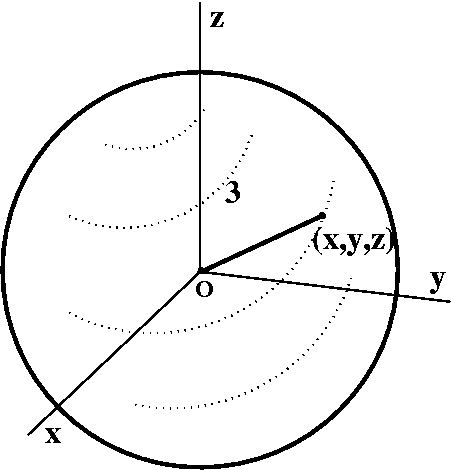
A sphere of radius 3
What algebraic condition on a point (x,y,z) is equivalent to the
geometric statement that the point lies on a sphere of radius 3
centered at (0,0,0)? This means that the distance from (x,y,z) to
(0,0,0) should be 3, or
sqrt((x-0)2+(y-0)2+(z-0)2)=3 which of
course is the same as x2+y2+z2=9.
Completing the square to "recognize" a sphere
We could of course "reverse" the process if we're given an equation
(or at least an equation of the correct form). For example, the equation
x2-3x+y2+4y+z2-7=0
represents a sphere. What is its center and its radius? The key
algebraic maneuver here is completing the square, and
everything works very much as in two dimensions.
x2-3x -->
x2+2(-3/2)x -->
x2+2(-3/2)x+(-3/2)2-(-3/2)2 -->
(x-3/2)2-(-3/2)2
y2+4y -->
y2+2(2y) -->
y2+2(2y)+22-22 -->
(y+2)2-22
We don't have any term with z to the first power. So the equation
becomes:
(x-3/2)2-(-3/2)2+(y+2)2-22+z2-7=0
which is the same as
(x-3/2)2+(y+2)2+(z-0)2=(-3/2)2+22+7
and we can "read off" that the center is (3/2,-2,0) and the radius is
sqrt((-3/2)2+22+7). It is easy to make mistakes
with minus signs when identifying the center. It is also easy to
forget to take the square root when identifying the radius. Oh well.
If we had different (but positive) numbers in front of the squares
(x2 and y2 and z2) then we'd get an
egg-shaped object, an ellipsoid. We'll see more about this
later.
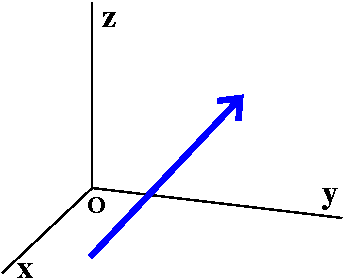
Vectors
A vector is a directed line segment. It is used as a
mathematical model for any quantity which has both magnitude and
direction. For example, some of the following quantities are vectors
and some are not:
|
|
Some vector quantities
Acceleration, velocity, displacement For velocity, for
example, the length of the vector corresponds to speed: "I am
traveling at 25 miles per hour" (in metric, I think that is 78
hectares per wombat). Of course the direction of the vector
corresponds to the direction of motion: "I am traveling at 25 miles
per hour North by Northwest" (in the metric system, this direction is
called "Colder").
Force Another basic example of a vector. The magnitude is
the amount of oomph in the force (I am giving up on units) while the
direction is the direction the force is pushing in.
Moment, torque, etc. You'll meet lots of vector
quantities. |
Things which aren't vectors
Mass (=energy, according to our good friend Albert).
Temperature
Quantities which are not vectors have the strange adjective,
scalars. So both Mass and Temperature are scalar quantities, and are
measured by numbers (both positive and negative) and have no intrinsic
direction.
|
 Equal vectors
Equal vectors
A vector can also be specified by its head and tail.
Two vectors will be called equal (maybe the official word is
equivalent) if when the tail of one of them is moved to the tail of
the other, then their heads are in the same place.
Vectors are used to do algebra in more than one dimension. This is
because algebra has really been successful, and the interaction
between algebra and geometry has paid off well in both
directions. Therefore we'll need to add and multiply vectors. Efforts
to multiply run into serious difficulties, as we will see next
time. Addition is neat and "everything" works well. As I mentioned in
class, the generally accepted definition for vector addition models
some situations which can be experienced and measured in "real life"
with forces, velocities, etc. The word resultant is sometimes
used in connection with this definition.
Definition of vector addition
| First suppose there are two vectors, v and w, which are
roaming, free and happy in R3. |
We take the vector w and drag it so that the tail of w is at
the same point as the head of v. |
The vector v+w is now defined using the geometric display we just
arranged. v+w the vector whose tail is at the tail of v and whose head
is at the head of w.
|

|
Properties of vector addition
- Reality Addition (superposition, resultant) of
vector quantities in physical "reality" is modeled by vector
addition. As I mentioned in class, there probably are many ways
we could define vector addition. This way is used because it
accurately models certain physical situations. Please keep this in
mind!
- Commutativity v+w=w+v for all pairs of vectors v and
w.
This can be proved from the geometric definition by drawing a
parallelogram which has one pair of sides translates of v and the
other pair of sides translates of w. Anyway, the order in which you
add vectors doesn't matter.
- Associativity (v+w)+u=v+(w+u) for all triples of vectors v,
w, and u.
I think this can be proved by drawing some
parallelopided (three-dimensional analogue of a parallelogram) with
sides gotten form v and w and u: but the diagram would almost be more
annoying than just thinking about it. The important consequence is
that you can group adding vectors in any way you want, and the result
will be the same.
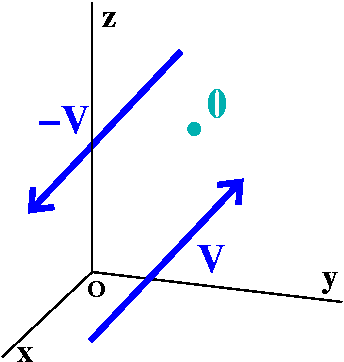
Zero and minus
The zero vector has its head equal to its tail. If v is a vector, then
-v is the vector whose length is v's but whose direction is the
reverse: so the head of -v is the tail of v and the tail of -v is the
head of v. Huh. Say that fast.
I am especially proud of the image of the zero vector in the picture
to the right. I wanted to show the special beauty of the zero
vector. I tried several different angles. (This is a joke!)
Then v+(-v)=0, and v+0=0 etc. for all vectors.
Scalar multiplication
In this course the scalars will be real numbers. Scalars are
things that multiply vectors. Many of the students in the course will
see later situations where the scalars are complex numbers. In the
case of the vectors arising in computer science and electrical
engineering, collections of scalars occur which are much less
familiar.
If c is a scalar and v is a vector, then the vector cv is defined by
the following:
If c>0 the direction of the vector cv is the same as the
direction of v, and the length of cv is the length of v multiplied by
c.
If c=0 then cv is the zero vector.
If c<0 the direction of the vector cv is the same as the
direction of -v and the length of cv is the length of v
multiplied by |c|. (The absolute value makes sure that lengths stay
positive.)
Here are pictures of v and -v and 3v and -2v.
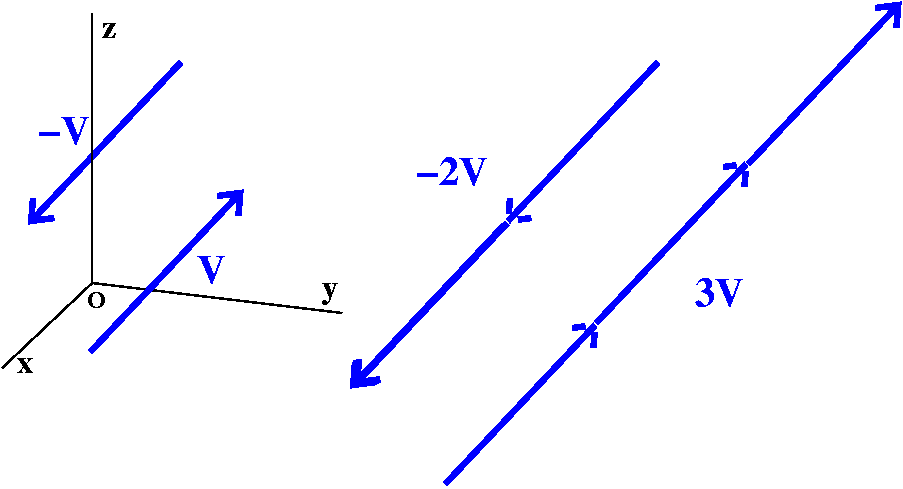
Important vectors
Some vectors are more important than others, especially if you have a
coordinate system. The vectors i and j and k are vectors of length 1
(such vectors are called unit vectors) which are parallel to
the coordinate axes x and y and z, respectively.
|
 |
Now take any vector v and move it so that the tail of v is at the
origin, (0,0,0). Then the head of v will be at some point, (a,b,c). If
you think about the geometry I hope you can convince yourself that
v=ai+bj+ck. We have written v as a sum of its components.
The textbook also uses the notation v=<a,b,c> for this. |
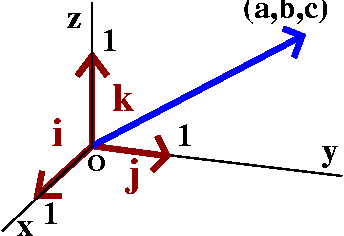 |
Vector addition in terms of components
Since vector addition is commutative and associative, and certainly
(c1+c2)(any vector)=(c1)(that vector)+(c2)(that vector),
we see clearly that if v=ai+bj+ck
and w=di+ej+fk, then v+w=(a+d)i+(b+e)j+(c+f)k.
The components of the sum are the sum of the respective components.
If you know the components, it is easy to compute vector sums and
scalar multiples of vectors.
The head and the tail produce the vector (algebraically)
Suppose the point P has coordinates
(x1,y1,z1) and the point Q has
coordinates (x2,y2,z2). Then the
vector from P to Q (so P is the tail and Q is the head) is just
(x2-x1)i+(y2-y1)j+(z2-z1)k.
I hope that you can draw a picture convincing yourself of that,
or you can look in the text.
Example The vector from P=(1,2,-3) to Q=(-5,6,2) is
(-5-1)i+(6-2)j+(2-[-3])k=-6i+4j+5k. It is easy to make mistakes with
signs in this computation.
How long is a vector?
I will use length and norm and magnitude to mean
the same thing about a vector: its length. If v=ai+bj+ck, then we can
think of the tail of v as sitting at (0,0,0) and the head of v, at
(a,b,c). The length formula we got then says that the length must be
sqrt(a2+b2+c2). So if you know the
components, the magnitude can be computed. In the textbook we are
using the magnitude is written ||v||. Please note that in some books
and some situations, this quantity is just written |v|.
NO! NO, NO, NO!!!
Suppose that v=<1,2,3> and w=<-2,3,2>. Then v+w=<-1,1,5>. And
||v||=sqrt(14) (approximately 3.74), ||w||=sqrt(17) (approximately 4.12),
and ||v+w||=sqrt(27) (approximately 5.19). In general, these numbers
need not be related in any simple fashion, aside from the Triangle
Inequality (see the textbook, please).
Next time I will explore how these lengths can be explained,
as we discuss multiplication of vectors.
After the class ...
I think the classroom is badly suiting to teaching math. Most of the
blackboards are barely visible to most of the chairs. Next time I will
try to teach at the narrow end of the room. I did investigate if any
other class rooms are available. Exactly one other room on College
Avenue is vacant at each class time, and both of those two rooms are
the same geometry as the one we have. They are both classrooms in a
river dorm! The physical plant at Rutgers is overused.
Start reading chapter 12, please. Do the problems.
Maintained by
greenfie@math.rutgers.edu and last modified 9/5/2008.
 A really silly (?) two-variable example
A really silly (?) two-variable example Tangent planes
Tangent planes Two half planes
Two half planes
 Now comes some of the harder stuff. I asked people to imagine that
some bugs were "walking" on the graph of z=f(x,y). The green bug, whose path is shown to the
right, strolls along in a path which is roughly circular around the
origin. This bug runs into trouble at any point on the positive
y-axis, where there's a drop. It also has problems along the negative
y-axis, where again there is a big difference in heights. This is a
very small bug. I have tried to indicate this by a sort of light
reddish color surrounding these half-lines. The
blue bug walks from the right halfplane to the left
halfplane. It is careful to cross only at the origin. The blue
bug is totally safe, and never comes across any severe height
differences. So I would like to discuss (and name [define], since it
is a math course!) the differences the bugs encounter more precisely.
Now comes some of the harder stuff. I asked people to imagine that
some bugs were "walking" on the graph of z=f(x,y). The green bug, whose path is shown to the
right, strolls along in a path which is roughly circular around the
origin. This bug runs into trouble at any point on the positive
y-axis, where there's a drop. It also has problems along the negative
y-axis, where again there is a big difference in heights. This is a
very small bug. I have tried to indicate this by a sort of light
reddish color surrounding these half-lines. The
blue bug walks from the right halfplane to the left
halfplane. It is careful to cross only at the origin. The blue
bug is totally safe, and never comes across any severe height
differences. So I would like to discuss (and name [define], since it
is a math course!) the differences the bugs encounter more precisely.




 The final example of misbehavior was the following function:
The final example of misbehavior was the following function: Slicing and partial derivatives
Slicing and partial derivatives



 Motion in a circular arc
Motion in a circular arc I hate to leave this subject since there is much more to be told, and
everything turns out to be amazingly useful in a wide variety of
applications. I hate to leave the subject, but the course is very
dense. So: just a little bit more. Think of an airplane flying along a
curve in the sky (the dashed red line). Then the unit tangent and
normal vectors are as shown. There's another vector, B, called the
binormal vector, which is TxN. Since T and N both have
length 1 and they are perpendicular, then B also has length 1 (sine of
a right angle is 1). And B is perpendicular to both T and N. The path
is determined by two functions. One of these functions is curvature
which says how much the plane is being pulled from a straight line. It
measures how much the T is changing in the N direction. Thegreen surface on the tail or the rudder of the
plane is the major object determining κ. But the motion is
three-dimensional. The way the binormal, B, changes, says how much the
plane is twisted out of the two dimensional plane determined by T and
B. The rate of change of B is called the torsion, and is
usually denoted by τ, the Greek letter tau. It is determined
mostly by the angles that the blue control
surfaces have with the wings. When a plane takes off or is landing,
these surfaces have relatively high angle to the wings.
I hate to leave this subject since there is much more to be told, and
everything turns out to be amazingly useful in a wide variety of
applications. I hate to leave the subject, but the course is very
dense. So: just a little bit more. Think of an airplane flying along a
curve in the sky (the dashed red line). Then the unit tangent and
normal vectors are as shown. There's another vector, B, called the
binormal vector, which is TxN. Since T and N both have
length 1 and they are perpendicular, then B also has length 1 (sine of
a right angle is 1). And B is perpendicular to both T and N. The path
is determined by two functions. One of these functions is curvature
which says how much the plane is being pulled from a straight line. It
measures how much the T is changing in the N direction. Thegreen surface on the tail or the rudder of the
plane is the major object determining κ. But the motion is
three-dimensional. The way the binormal, B, changes, says how much the
plane is twisted out of the two dimensional plane determined by T and
B. The rate of change of B is called the torsion, and is
usually denoted by τ, the Greek letter tau. It is determined
mostly by the angles that the blue control
surfaces have with the wings. When a plane takes off or is landing,
these surfaces have relatively high angle to the wings. 




 Curvature is a number which measures how a curve bends
Curvature is a number which measures how a curve bends


 I defined the unit
tangent vector, T, to be a unit vector in the direction of
r´(t). If θ is the angle that r´(t) makes with the positive
x-axis, then T must be cos(θ)i+sin(θ)j.
Also r´(t)=(ds/dt)T, where ds/dt is the length of r´(t),
the speed. Now differentiate the formula for r´(t) using
one of the product rules we had stated earlier. The result is
r´´(t)=(d2s/dt2)T+ (ds/dt)d/dt(T). But T is
cos(θ)i+sin(θ)j, and differentiation with respect to t is the
same as differentiation with respect to s multiplied by ds/dt. But
differentiation with respect to s gives (-sin(θ)i+cos(θ)j)
multiplied by the derivative of θ with respect to s, and this is
κ. All this put together is:
I defined the unit
tangent vector, T, to be a unit vector in the direction of
r´(t). If θ is the angle that r´(t) makes with the positive
x-axis, then T must be cos(θ)i+sin(θ)j.
Also r´(t)=(ds/dt)T, where ds/dt is the length of r´(t),
the speed. Now differentiate the formula for r´(t) using
one of the product rules we had stated earlier. The result is
r´´(t)=(d2s/dt2)T+ (ds/dt)d/dt(T). But T is
cos(θ)i+sin(θ)j, and differentiation with respect to t is the
same as differentiation with respect to s multiplied by ds/dt. But
differentiation with respect to s gives (-sin(θ)i+cos(θ)j)
multiplied by the derivative of θ with respect to s, and this is
κ. All this put together is:
 A racetrack: this racetrack consists, as nearly as possible, of two
straight line segments, each about 3 miles long, connected with a
semicircular track. Since the racetracks were specified to be 2 miles
apart, we "deduce" that the radius of the semicircle is 1 mile. The
racetracks certainly have curvature=0, and the semicircle, which is Pi
units long, has curvature 1. What would a graph of
the curvature of this racetrack look like?
A racetrack: this racetrack consists, as nearly as possible, of two
straight line segments, each about 3 miles long, connected with a
semicircular track. Since the racetracks were specified to be 2 miles
apart, we "deduce" that the radius of the semicircle is 1 mile. The
racetracks certainly have curvature=0, and the semicircle, which is Pi
units long, has curvature 1. What would a graph of
the curvature of this racetrack look like?
 An answer
An answer





 Let's find the parametric equations of a line tangent to this helix
when t=Pi/2. The line must pass through
r(2)=<3cos(2[pi/2]),3sin(2[Pi/2]),8[Pi/2]>=<-3,0,4Pi>. A
vector in the tangent direction can be gotten from the velocity
vector. So: r´(t)=<-6sin(2t),6cos(2t),8> which, when
t=Pi/2, gives <0,-6,8>. Therefore the parametric equations for
the line are:
Let's find the parametric equations of a line tangent to this helix
when t=Pi/2. The line must pass through
r(2)=<3cos(2[pi/2]),3sin(2[Pi/2]),8[Pi/2]>=<-3,0,4Pi>. A
vector in the tangent direction can be gotten from the velocity
vector. So: r´(t)=<-6sin(2t),6cos(2t),8> which, when
t=Pi/2, gives <0,-6,8>. Therefore the parametric equations for
the line are: Problem 28
Problem 28
 Specifying a line
Specifying a line Specifying a plane
Specifying a plane Distance of a point to a plane
Distance of a point to a plane I guess two lines are parallel if they are distinct (that is,
separate lines!) and if their directions are non-zero multiples of one
another. So, for example, the lines
I guess two lines are parallel if they are distinct (that is,
separate lines!) and if their directions are non-zero multiples of one
another. So, for example, the lines Parallel planes
Parallel planes
 As dimensions increase, generally geometry gets more complicated. One
phenomenon which does not occur in two dimensions is skew
lines. A pair of lines is skew if they are not parallel and
also do not intersect. So look at, say, the x-axis (where parametric
equations could be x=t,y=0,z=0) and a line through (0,1,0) which is
tilted with respect to the x-axis: x=t,y=1,z=t. These lines don't
intersect since no point with second coordinate 0 is on the second
line. They aren't parallel since <1,0,0>, the direction of the first
line, is not a non-zero scalar multiple of <1,0,1>. So they are skew.
As dimensions increase, generally geometry gets more complicated. One
phenomenon which does not occur in two dimensions is skew
lines. A pair of lines is skew if they are not parallel and
also do not intersect. So look at, say, the x-axis (where parametric
equations could be x=t,y=0,z=0) and a line through (0,1,0) which is
tilted with respect to the x-axis: x=t,y=1,z=t. These lines don't
intersect since no point with second coordinate 0 is on the second
line. They aren't parallel since <1,0,0>, the direction of the first
line, is not a non-zero scalar multiple of <1,0,1>. So they are skew.  Looking at lengths again
Looking at lengths again Let me continue using the v=<3,2,-1> and w=<5,2,6> from the previous
question. I'd like to show you how to write v as a sum of two
vectors, v|| and v⊥ where v⊥
is perpendicular to w and v|| is parallel to w. This will
be useful several times in the course, and is also important in
physics.
Let me continue using the v=<3,2,-1> and w=<5,2,6> from the previous
question. I'd like to show you how to write v as a sum of two
vectors, v|| and v⊥ where v⊥
is perpendicular to w and v|| is parallel to w. This will
be useful several times in the course, and is also important in
physics.

 Take your right hand and extend your
thumb. Curl up your fingers. Insert your hand (I guess by though, not
physically) so that your fingers go from v to w. Then
your thumb will be (sort of) pointed perpendicular to the plane
containing v and w. That perpendicular direction is the direction of
vxw.
Take your right hand and extend your
thumb. Curl up your fingers. Insert your hand (I guess by though, not
physically) so that your fingers go from v to w. Then
your thumb will be (sort of) pointed perpendicular to the plane
containing v and w. That perpendicular direction is the direction of
vxw.
 This wasn't too hard,
although getting the directions correct involved some thought
and some physical contortions. These are unit vectors and all mutually
perpendicular. If the vectors in the product are the same, then the
parallelogram involved collapses to a line segment and has no area. If
the vectors are different, then the parallelgram is a square with 1
unit sides, and has area 1. The important thing is the sign of the
answer and its direction. I tried to get that correct. If you were not
in class or you were confused, I urge you to try to get some of the
entries in this table yourself.
This wasn't too hard,
although getting the directions correct involved some thought
and some physical contortions. These are unit vectors and all mutually
perpendicular. If the vectors in the product are the same, then the
parallelogram involved collapses to a line segment and has no area. If
the vectors are different, then the parallelgram is a square with 1
unit sides, and has area 1. The important thing is the sign of the
answer and its direction. I tried to get that correct. If you were not
in class or you were confused, I urge you to try to get some of the
entries in this table yourself. This is supposed to be the real line. There's an origin and a
unit length, and the conventional choice is to make the positive
direction go off to the right. Each point on the line corresponds to a
real number. The distance between points on the line which correspond
to the real numbers a and b is defined to be |a-b|.
This is supposed to be the real line. There's an origin and a
unit length, and the conventional choice is to make the positive
direction go off to the right. Each point on the line corresponds to a
real number. The distance between points on the line which correspond
to the real numbers a and b is defined to be |a-b|.
 And here is the plane (I don't think I've ever heard anyone
call it the "real plane"). The simplest situation is what's shown
here. Two straight lines as axes, perpendicular to each. Every point
corresponds to a unique ordered pair of real numbers. There is a set
unit length on each coordinate axis, and almost always right is
positive and up is positive. Later in the course we will consider
situations where the coordinate axes are not necessarily
perpendicular. And even where what corresponds to the axes are not
straight. I hope that tilted axes could make sense if, for
example, you were interested in looking at crystals which did not have
rectangular symmetry.
And here is the plane (I don't think I've ever heard anyone
call it the "real plane"). The simplest situation is what's shown
here. Two straight lines as axes, perpendicular to each. Every point
corresponds to a unique ordered pair of real numbers. There is a set
unit length on each coordinate axis, and almost always right is
positive and up is positive. Later in the course we will consider
situations where the coordinate axes are not necessarily
perpendicular. And even where what corresponds to the axes are not
straight. I hope that tilted axes could make sense if, for
example, you were interested in looking at crystals which did not have
rectangular symmetry.
 In three dimensions, the geometric situation is specified by three
mutually perpendicular lines. Points will correspond to ordered
triples of real numbers. In almost every situation you are likely to
encounter, these axes will be right-handed. Right-handed means
... means ... means ... well, it means what I sketched to the right
(heh heh). The three dimensional world is complicated, and you will
see that the choice of right-handedness has some interesting
consequences.
In three dimensions, the geometric situation is specified by three
mutually perpendicular lines. Points will correspond to ordered
triples of real numbers. In almost every situation you are likely to
encounter, these axes will be right-handed. Right-handed means
... means ... means ... well, it means what I sketched to the right
(heh heh). The three dimensional world is complicated, and you will
see that the choice of right-handedness has some interesting
consequences.
 Perilous pictures
Perilous pictures










 Equal vectors
Equal vectors


